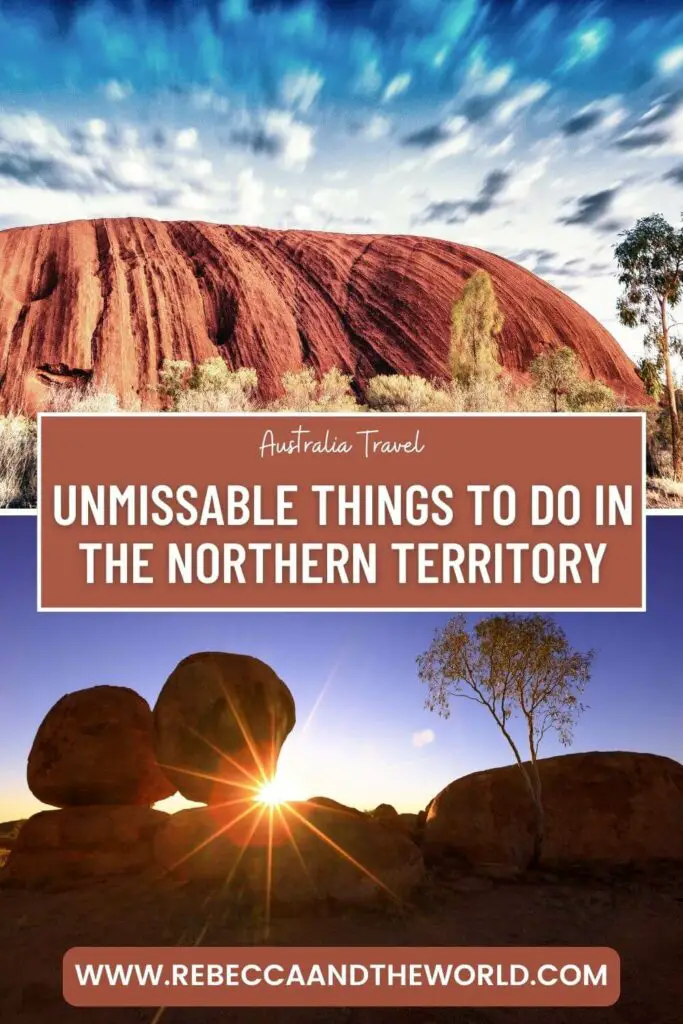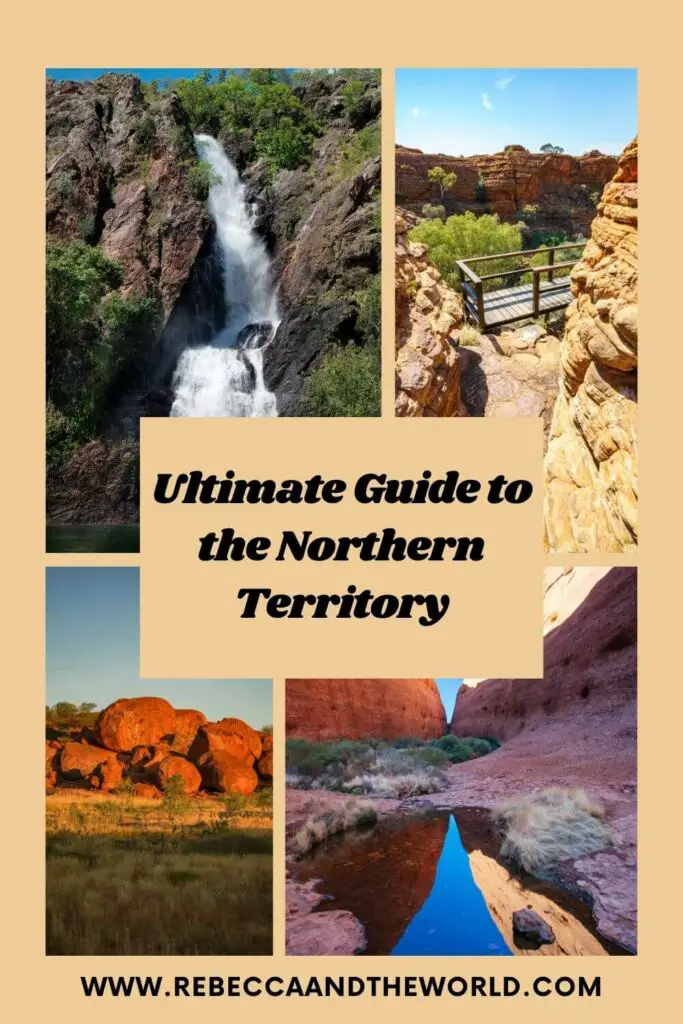Looking for some amazing things to do in the Northern Territory? Australia’s most unique territory is one of my favourites – here are my suggestions for unmissable things to do and places to see.
The Northern Territory – Australia’s most unique and captivating state (well, territory, not a state).
With its laidback lifestyle, stunning scenery and rich culture, it’s no wonder that people come here for a few months and end up staying for years.
As someone who has visited the NT a handful of times and always finds something new to fall in love with each time, here’s a guide to my picks for what you MUST do when you visit. From natural wonders to cultural experiences, there are some pretty amazing things to do in the Northern Territory – and plenty to keep you coming back time and time again.
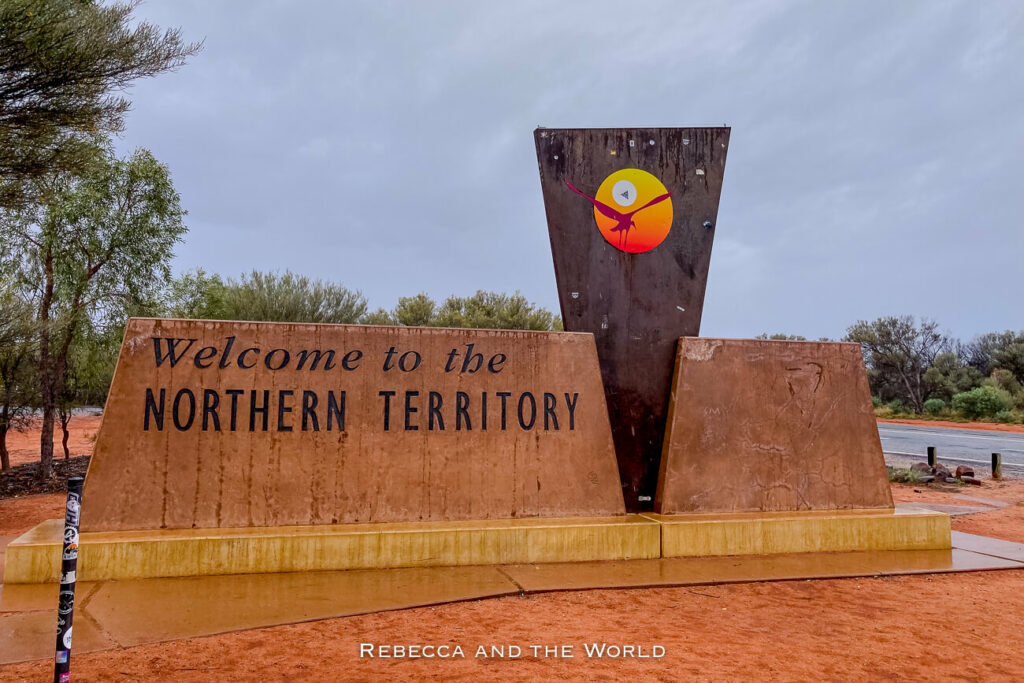
This blog post may contain affiliate links, meaning if you book or buy something through one of these links, I may earn a small commission (at no extra cost to you).
1. Drive the length of the Stuart Highway
One of the most iconic road trips in Australia, driving the length of the Stuart Highway will take you all the way through the heart of the Northern Territory, from South Australia and up to Darwin.
Spanning more than 3,000 kilometres, this highway is a great way to experience the vastness and beauty of the Australian outback. While the Stuart Highway technically starts in Port Augusta, South Australia, you should start your trip in the pretty capital city of Adelaide. Along the way, stop at remote towns, iconic Outback pubs and stunning national parks for a true taste of outback life.
Ideally you’ll have 10 days to 2 weeks to drive the entire length, but if you’re short on time you can tackle it in a week or less.
But this is the Outback – and it’s best travelled slowly.
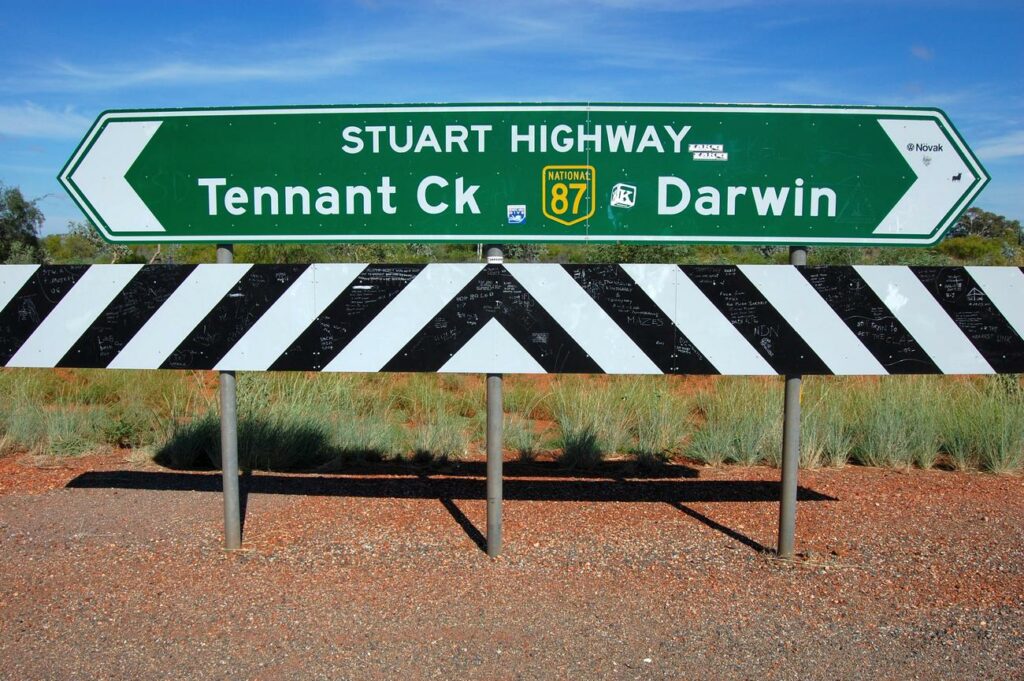
2. Chase waterfalls at Litchfield NP
A favourite spot of both Territorians and visitors alike, Litchfield National Park is just a short drive from Darwin.
While you can visit on a day trip, I highly recommend spending a few days in this stunning park that’s home to countless waterfalls, swimming holes and walking trails.
Spend your days exploring the rainforest and cascading falls, cooling off in crystal clear pools and picnicking in picturesque spots. Don’t miss Florence Falls or Wangi Falls, both popular spots for a refreshing dip.
If you’ve got a 4WD and a sense of adventure, take a drive to the remote Surprise Creek Falls.
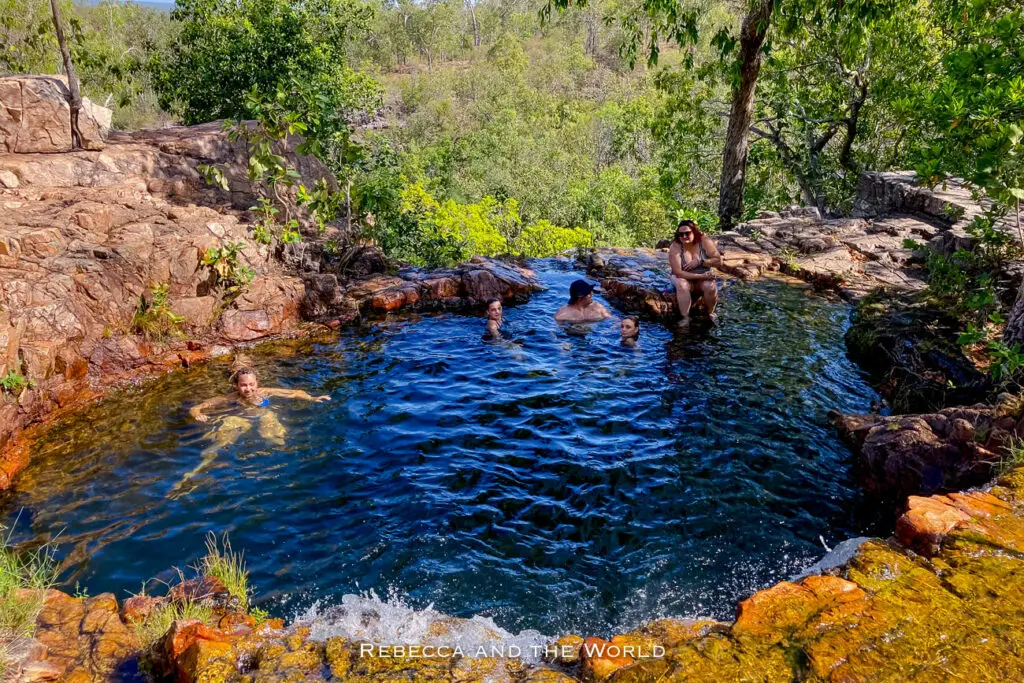
3. Explore Kakadu National Park
No trip to the Northern Territory is complete without a visit to the stunning Kakadu National Park. This World Heritage-listed site covers nearly 20,000 square kilometres and is filled with ancient rock art, breathtaking waterfalls and more than 10,000 saltwater crocs.
Take a cruise on Yellow Water Billabong to see dozens of species of birds, buffalo and far more crocs than you can count.
Rock art that’s thousands of years old fill shelters. At Burrungkuy (Nourlangie), you’ll see paintings of people, kangaroos and fish, as well as Namarrkon, the famous Lightning Man. At the Nanguluwurr art gallery, you’ll see the painting of a masted sailing ship – a representation of early contact between Aboriginal people and Europeans.
Wash off the dust in one of Kakadu’s natural swimming holes – Maguk Falls in the park’s south is my favourite.
Spend a sunset at Ubirr, where the views stretch out over the vast Kakadu floodplains all the way to Arnhem Land.
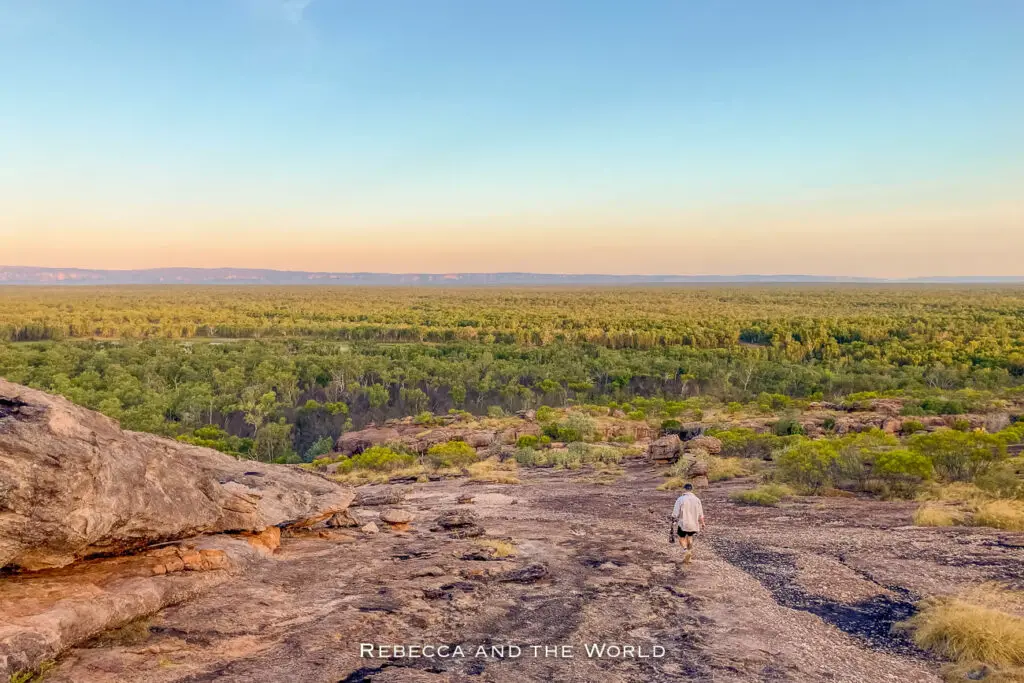
4. Drive the Red Centre Way
Take a road trip along the famous Red Centre Way for a meander through some of Australia’s most breathtaking landscapes, including Uluru (Ayers Rock) and Kata Tjuta (The Olgas).
The route starts and ends in Alice Springs and can be done in a week. If you’ve got a 4WD, it’s a 1,100-kilometre loop on both sealed and unsealed roads.
Only got a 2WD? The trip is still possible, but you will have to do a little backtracking to return to Alice.
As well as Uluru and Kata Tjuta, there’s the lesser-known but equally stunning Kings Canyon in Watarrka National Park. The canyon rim hike is undoubtedly one of the best in Australia.
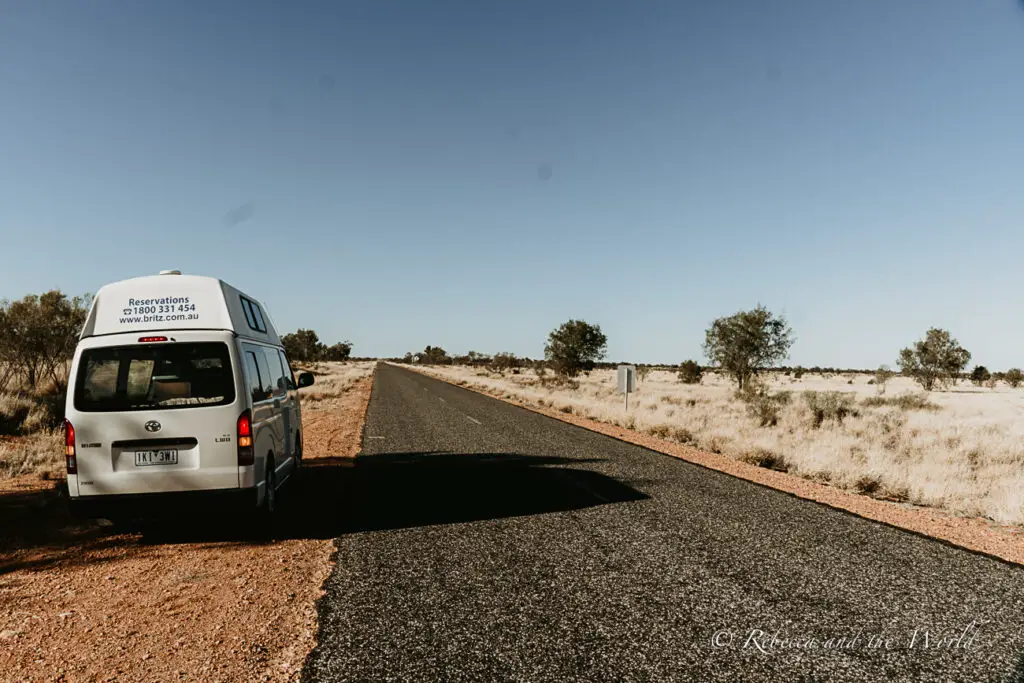
5. Soak in natural hot springs
The NT has a lot of Instagram-worthy spots, but its hot springs must surely top the list. After a long day of exploring, nothing beats soaking in a natural hot spring.
The most easily accessible is Katherine Hot Springs. Katherine is one of my favourite Northern Territory destinations, and right in the middle of town, these hot springs bubble up from the ground at a refreshing temperature of 25-30 degrees Celsius.
An hour from Katherine is the small town of Mataranka. Here, you’ll find my top pick for hot springs: Bitter Springs. In Elsey National Park, these natural springs are surrounded by lush vegetation and crystal-clear, turquoise water.
Also in Elsey National Park, the Mataranka Thermal Pools are another great spot. They’re usually busier than Bitter Springs, but the setting is equally as divine.
As you can imagine, all these hot springs get pretty busy, so try to go early in the day to avoid the crowds.
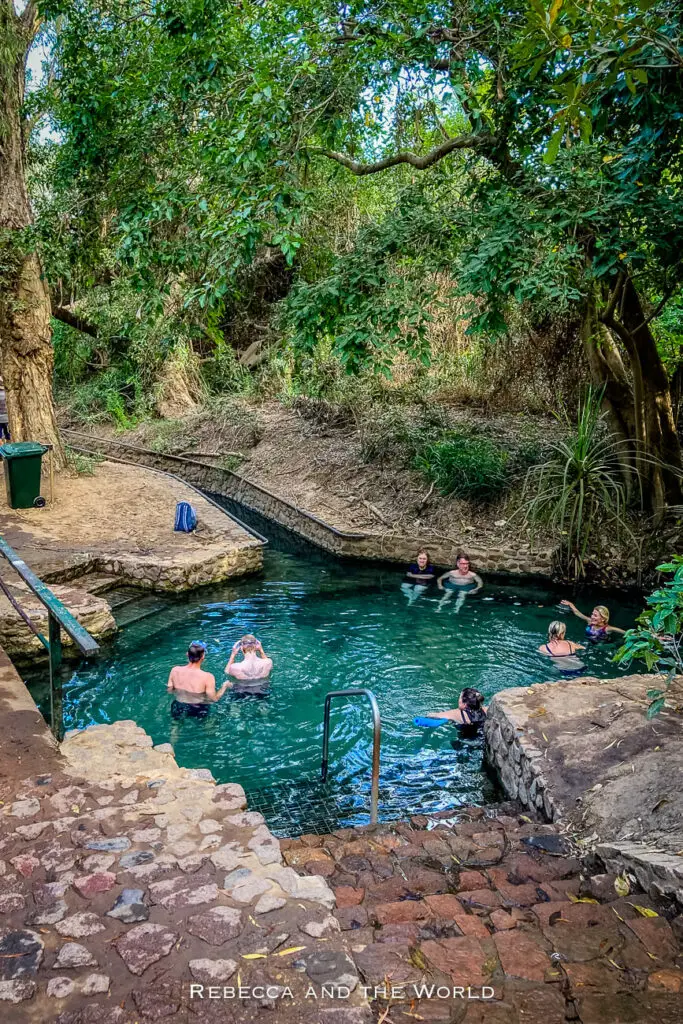
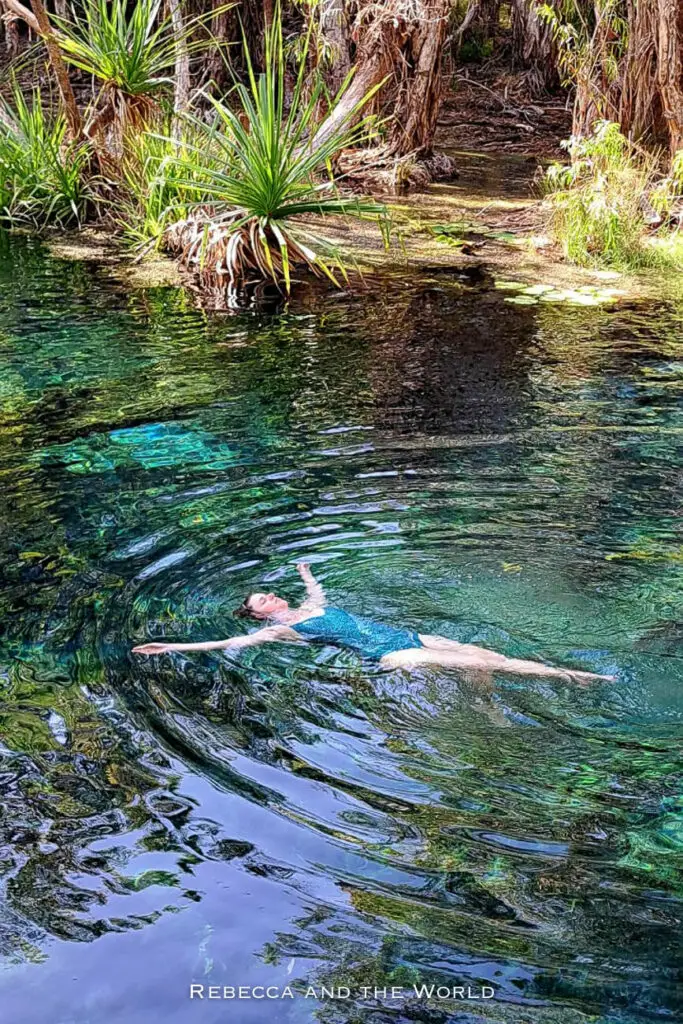
6. Take a dip in a swimming hole
As well as hot springs and waterfalls, the NT has some incredible swimming holes.
In the Red Centre, head out along the West MacDonnell Ranges where you’ll find spots like Redbank Gorge (Yarretyeke). Prepare for a shock – the water here is cold, but if you bring an inflatable, you can float your way through the pools and caverns.
Nearby, also in the West Macs, are Ellery Creek Big Hole and Ormiston Gorge. Both have deep, cold water that’s perfect for a refreshing dip on a hot day (which is most days in the NT!).
Just 60km north of Katherine, Leliyn (Edith) Falls in Nitmiluk National Park is one of the most beautiful spots for a dip. The plunge pool at the Upper Pool is surrounded by red cliffs and plenty of shady (although rocky) spots for a picnic.
In Litchfield National Park, Buley Rockhole is a fantastic spot – find your own piece of chilly water in this set of tiered pools. If the crowds here get too much, you can hike to the Upper Cascades and Tjaetaba Falls for quieter spots for a swim.
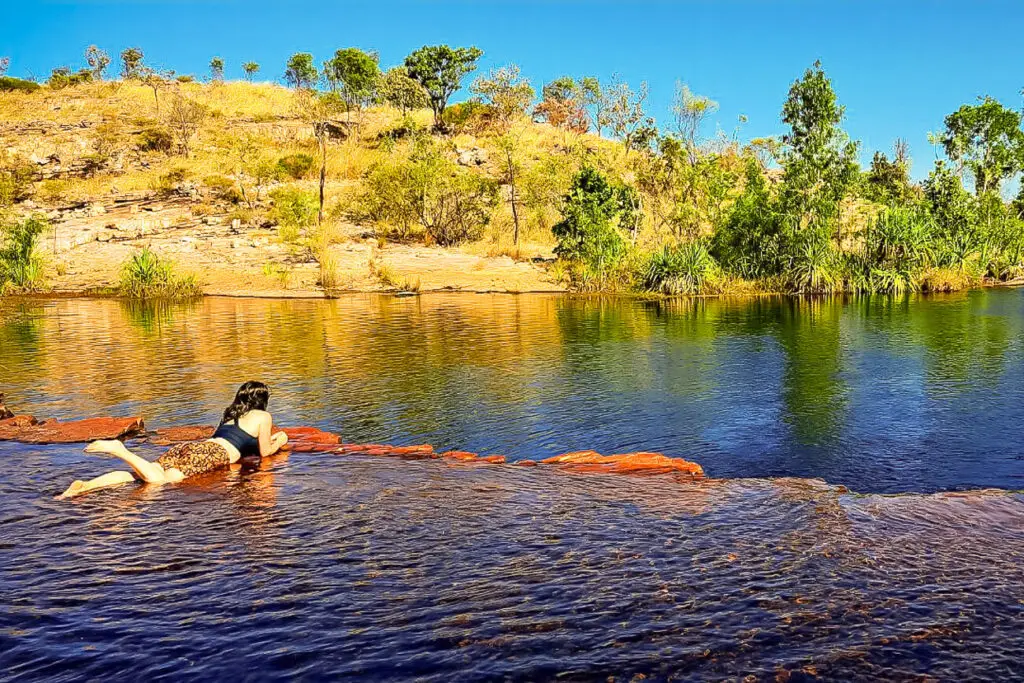
7. Hike through Nitmiluk National Park
If you’re up for a bit of adventure, Nitmiluk National Park, just outside of Katherine, has plenty of it. This series of 13 gorges has been carved out by the Katherine River over centuries, and is a special place to the Jawoyn people, the Traditional Owners.
The easiest trail is the Baruwei Lookout. This 1.8km return walk ends with beautiful views of the gorge from above.
For something a little more challenging, tackle one of the longer Southern Walks. Ranging from 9.1km to 23.8km – plus some multi-day hikes – these trails lead into the further gorges. I loved the Butterfly Gorge hike, which includes an optional swim at the gorge at the end.
Not up for a hike? You can also experience Nitmiluk by paddling a kayak down the river or taking a relaxing boat ride through a few of the gorges, with a guide to share interesting facts about the area.
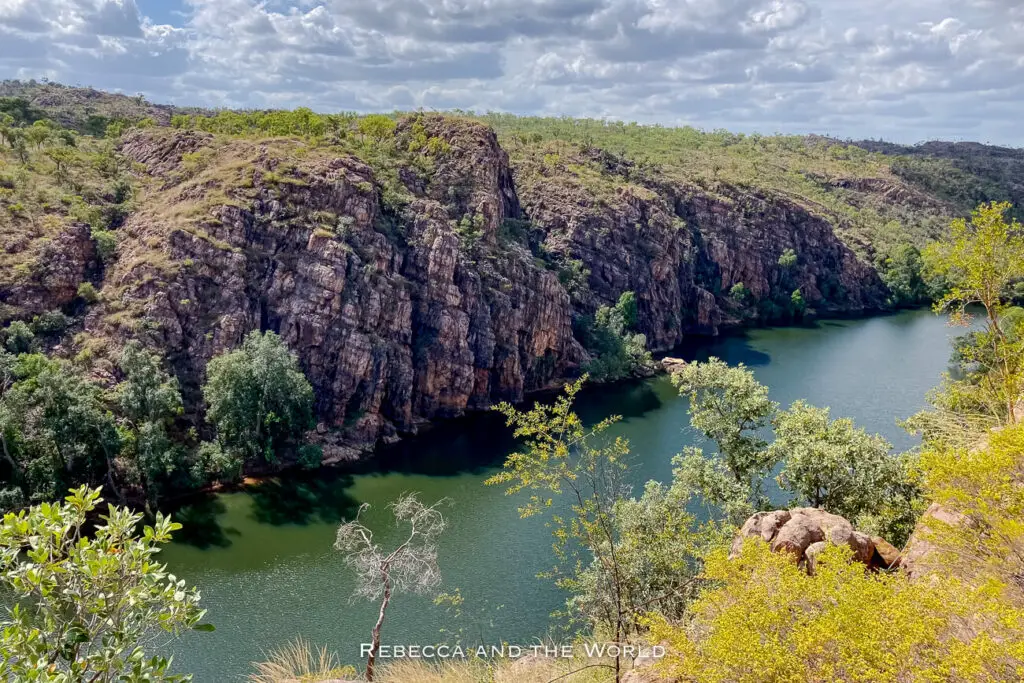
8. Catch an epic sunset
The NT has some epic sunsets. I felt like every every evening I was proclaiming the best sunset I’ve ever seen – only to be outdone the next night.
Darwin’s beaches are a good place to catch one of them. The most popular place to catch the sunset is Mindil Beach, where there’s also a twice-weekly market during the dry season that’s worth checking out.
For a less crowded experience, head to East Point Reserve or Nightcliff foreshore. Both have stunning views and a chilled atmosphere to take in the beautiful colours of the sunset. Nightcliff is definitely my favourite – I just couldn’t believe how big and orange the sun could be as it sets.
Further south, Ubirr in Kakadu is famous for its sunsets. Looking out over Arnhem Land and the floodplains, you’ll see an incredible array of colours as the sun sets behind the escarpment.
And if you happen to be in Alice Springs, head out to Anzac Hill/Untyeyetwelye for a beautiful view of the sunset over the MacDonnell Ranges.
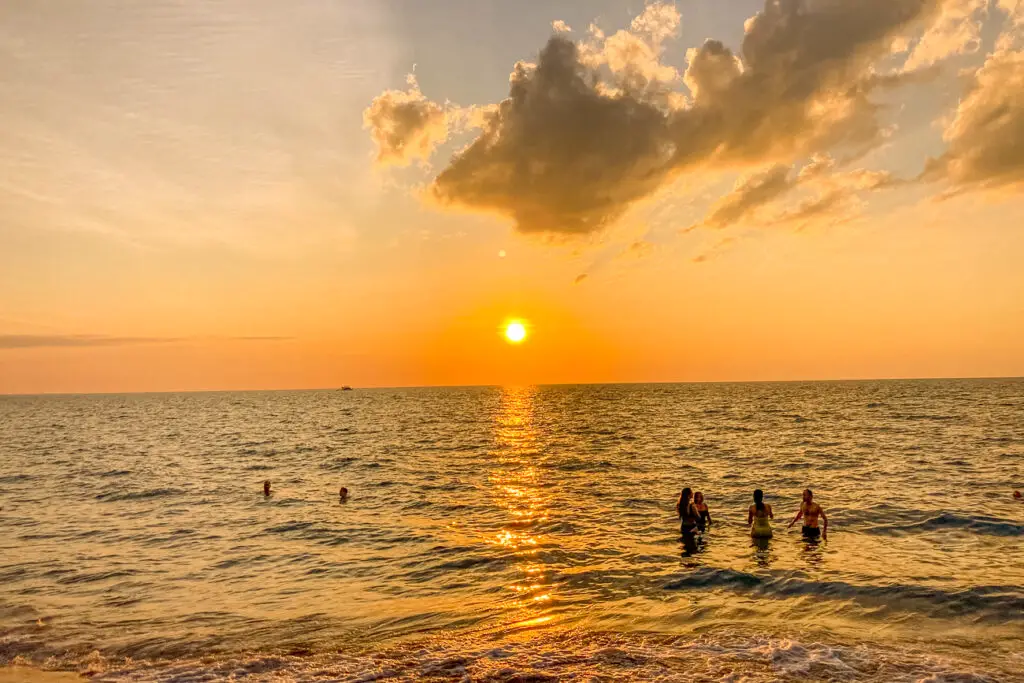
9. Watch Uluru change colour
Arguably Australia’s most iconic landmark, the sacred rock formation of Uluru is best viewed at sunrise or sunset when the rock changes colours.
As the sun rises or sets, the light reflects off the surface of Uluru, causing it to change from shades of red and orange to purple and even blue. It’s a mesmerising sight – and I think you should do both sunrise and sunset just to see how different Uluru can look.
Or take a helicopter tour to see her beauty and magnificence from the air.
During the day, take a walk around the base of Uluru to get up close with the rich red colour and intricate patterns of the rock. You’ll see paths ground out of the rock as rain has made its way down Uluru over thousands and thousands of years.
This is one of the most famous sights in Australia and can’t be missed.
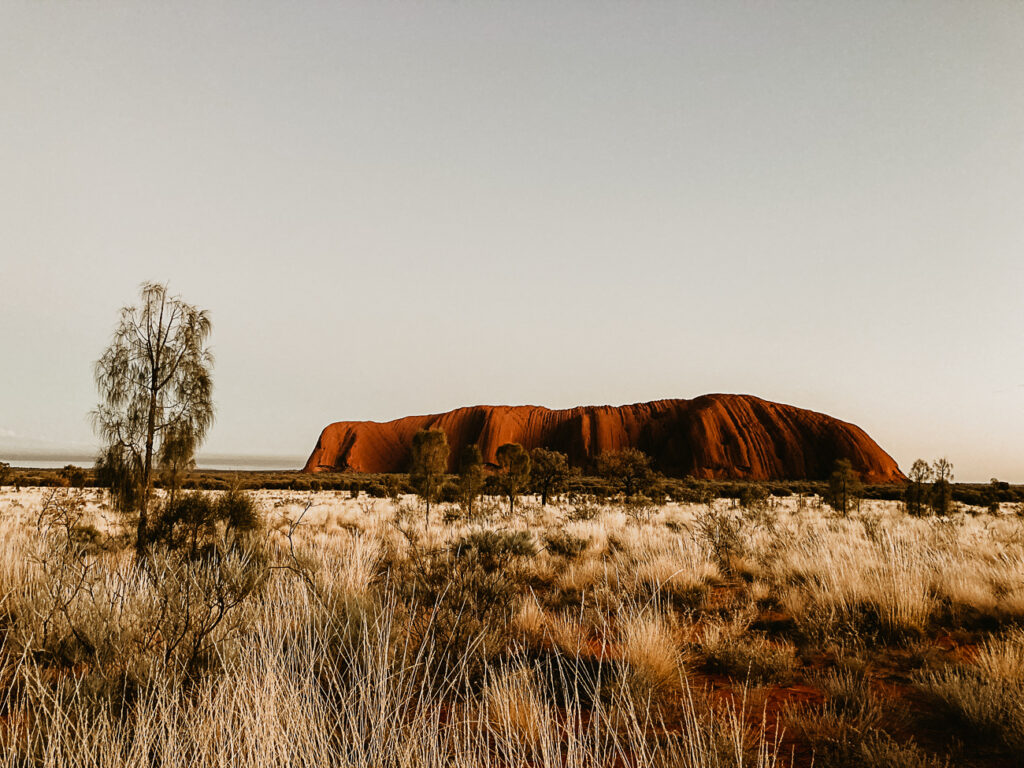
10. Watch the sky light up at Uluru
As well as seeing a spectacular sunset or sunrise, there are so many things to do at Uluru, including the fantastic Field of Lights.
This stunning light installation by renowned artist Bruce Munro features more than 50,000 lights that change colour as the sky darkens. You can walk through these lights, with Uluru as the backdrop.
The newest experience at Uluru is Wintjiri Wiru, a drone show that tells the ancient Mala story from Kaltukatjara to Uluru. More than 1,100 drones light up the sky to share an ancient story using modern-day technology. It’s the first time an Indigenous story has been told in this way.
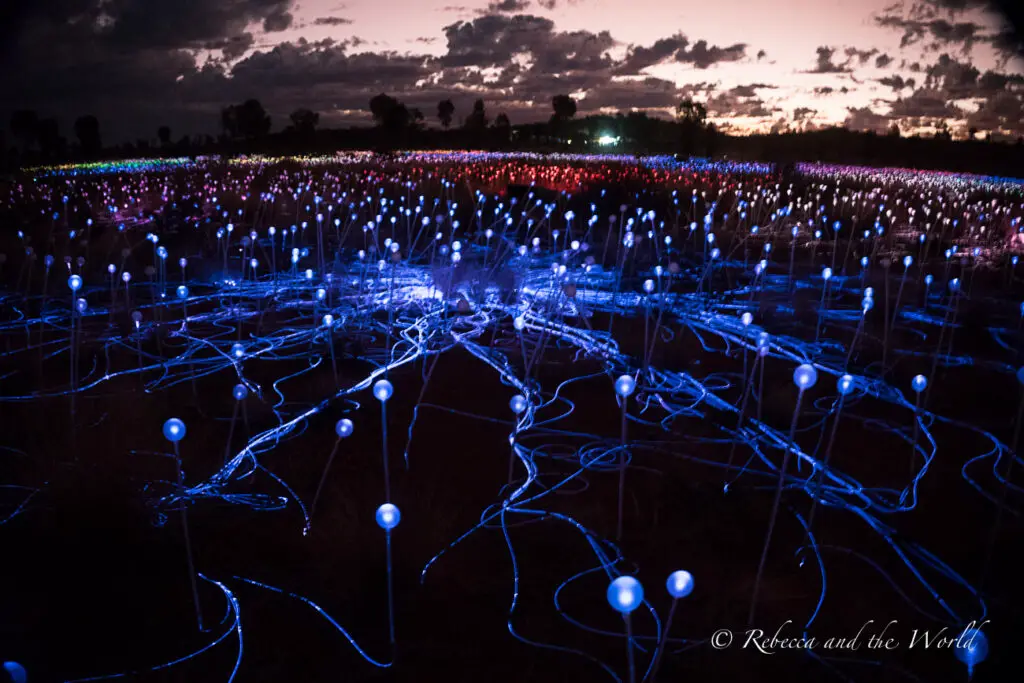
11. Hike through Kata Tjuta’s famous domes
Uluru may be Australia’s most famous landmark, but it’s not the only incredible rock formation in the area.
Just a short drive away, Kata Tjuta (also known as The Olgas) is another impressive formation made up of 36 domes that are over 500 million years old.
The most popular way to experience Kata Tjuta is on foot. There are several hikes you can choose from, varying in difficulty and length. The Valley of the Winds hike takes you through the heart of Kata Tjuta, offering breathtaking views of the domes and surrounding landscape. It’s a 7.4km loop in full, but there are shorter in-and-out sections.
Walpa Gorge is another great hike. This 3km walk takes you through a narrow gorge, surrounded by towering domes on either side.
And, like Uluru, seeing sunrise or sunset at Kata Tjuta is a must.
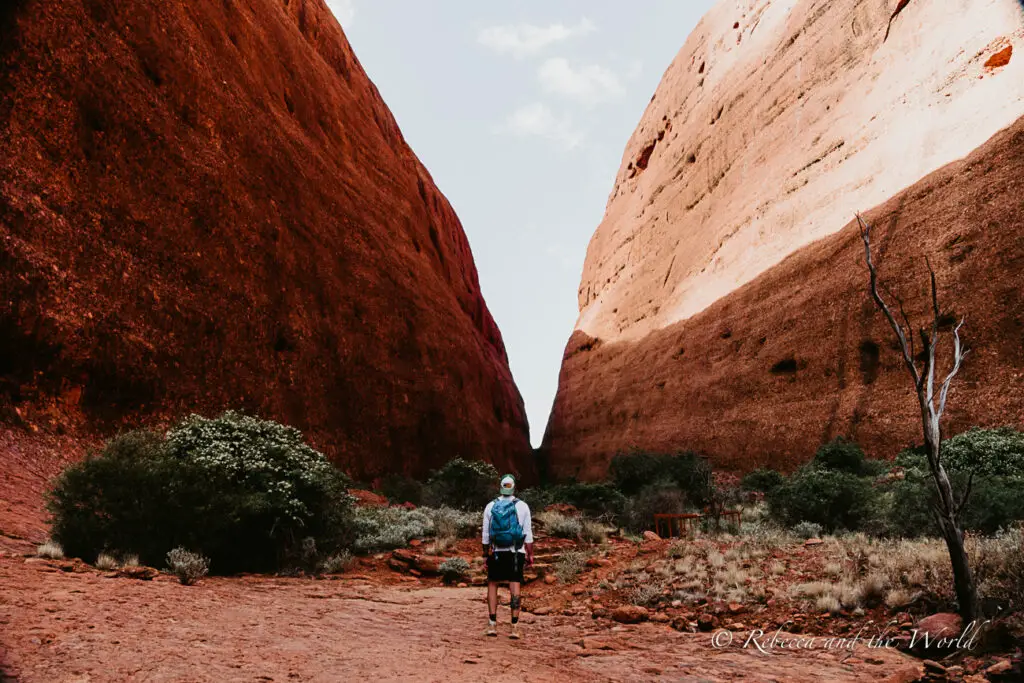
12. Walk the rim of Kings Canyon
Kings Canyon is another stunning natural wonder in the Red Centre of Australia.
Located in Watarrka National Park, this massive sandstone canyon plunges more than 150 metres deep and offers breathtaking views of the surrounding desert landscape.
One of the best ways to experience Kings Canyon is by walking along its rim. This 6km hike takes you through various landscapes, from lush vegetation to rocky cliffs. Along the way, you’ll see iconic landmarks like the Lost City and the Garden of Eden. The walk can be challenging in some parts, but it’s worth it for the incredible views at the top.
Make sure to bring plenty of water and sunscreen, as there’s little shade along the rim.
Can’t be bothered hiking? Take a helicopter ride to see this canyon in all its glory.
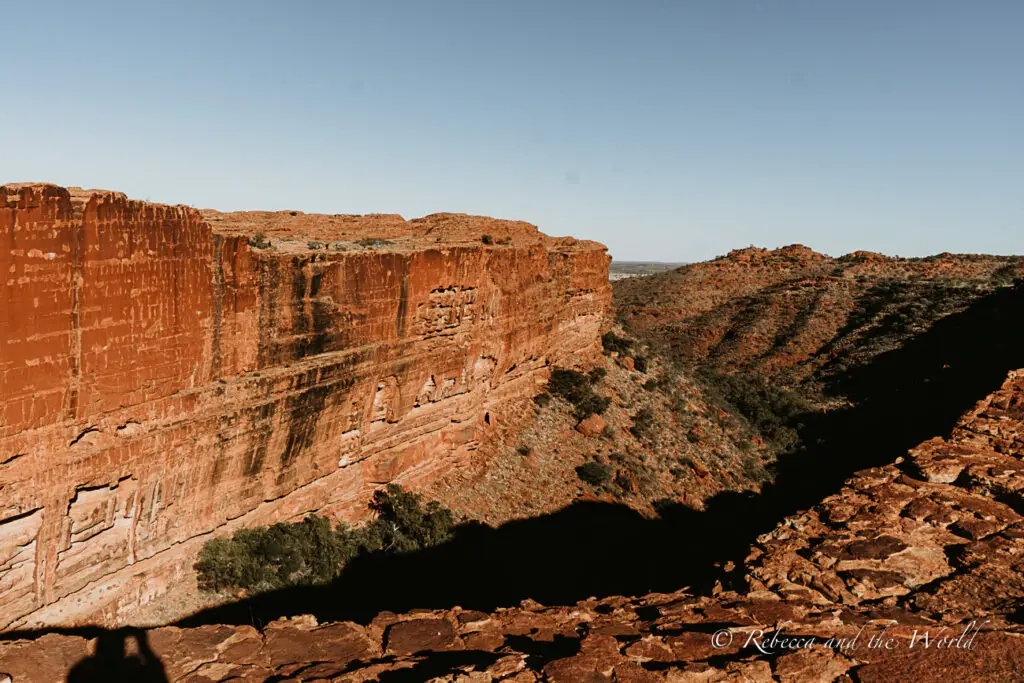
13. Visit Darwin’s famous markets
Darwin, the capital city of Australia’s Northern Territory, is known for its vibrant and diverse markets.
The Mindil Beach Sunset Market is perhaps the most famous market in Darwin. Held every Thursday and Sunday evening during the dry season, there are more than 300 stalls selling everything from local produce to handmade crafts.
But the market isn’t just about shopping – it’s also a great place to try delicious food from around the world. From Thai street food to Greek gyros to deep-fried crocodile, it’s worth spending an evening sampling from the many vendors.
And as the name suggests, you can enjoy all of this while watching the stunning sunset over Mindil Beach.
Other popular markets in Darwin include the Parap Village Market, which also has some incredible food – including cult-like laksa soups.
The Rapid Creek Markets are another must-visit, with more of a local vibe.
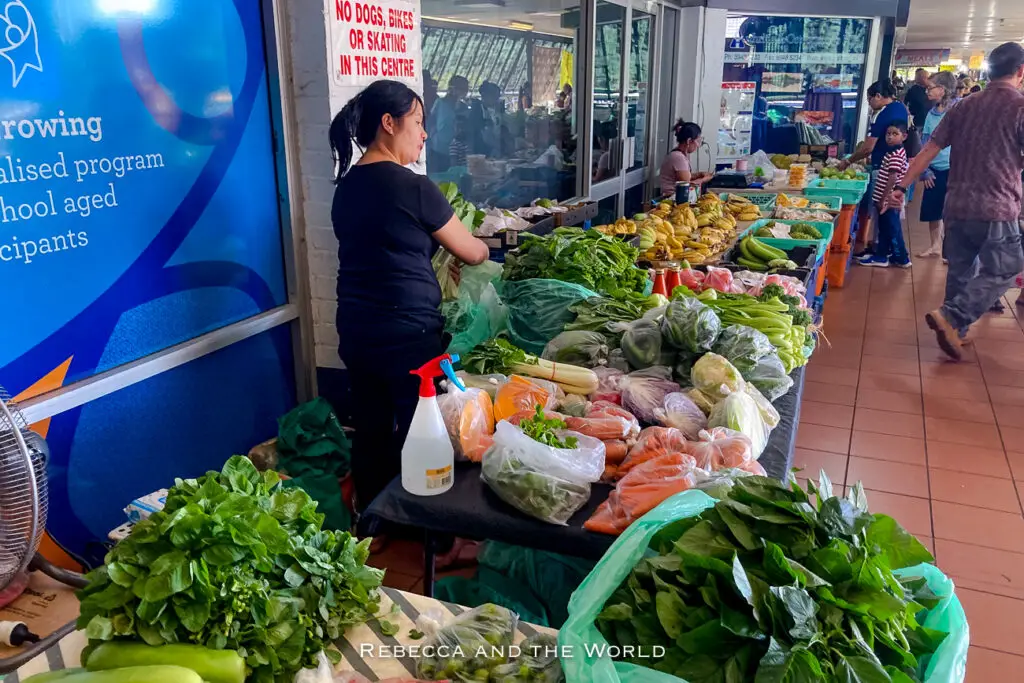
14. Dine under the stars
Eating out under the stars with Uluru as a backdrop is a must-do experience when you visit Uluru-Kata Tjuta National Park.
While the two dining experiences aren’t cheap, they are incredible.
Tali Wiru offers a luxury dining experience, where you can enjoy a gourmet four-course meal while surrounded by the rugged outback landscape. Canapes and drinks are served as a yidaki (didgeridoo) is played, and the meal ends with an Aboriginal astronomy lessons and hot chocolate and cognac by the fire.
For a (slightly) more budget-friendly option, head to Sounds of Silence – an open-air buffet dinner with stunning views of Uluru at sunset. You’ll also have the opportunity to stargaze and learn about Aboriginal stories and culture from a local guide.
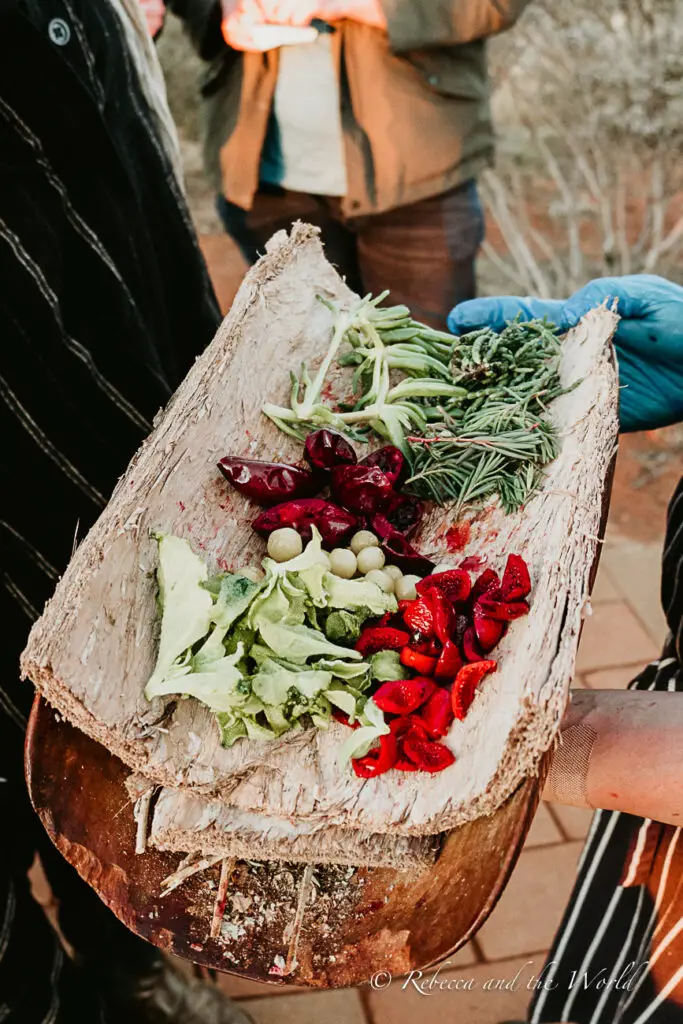
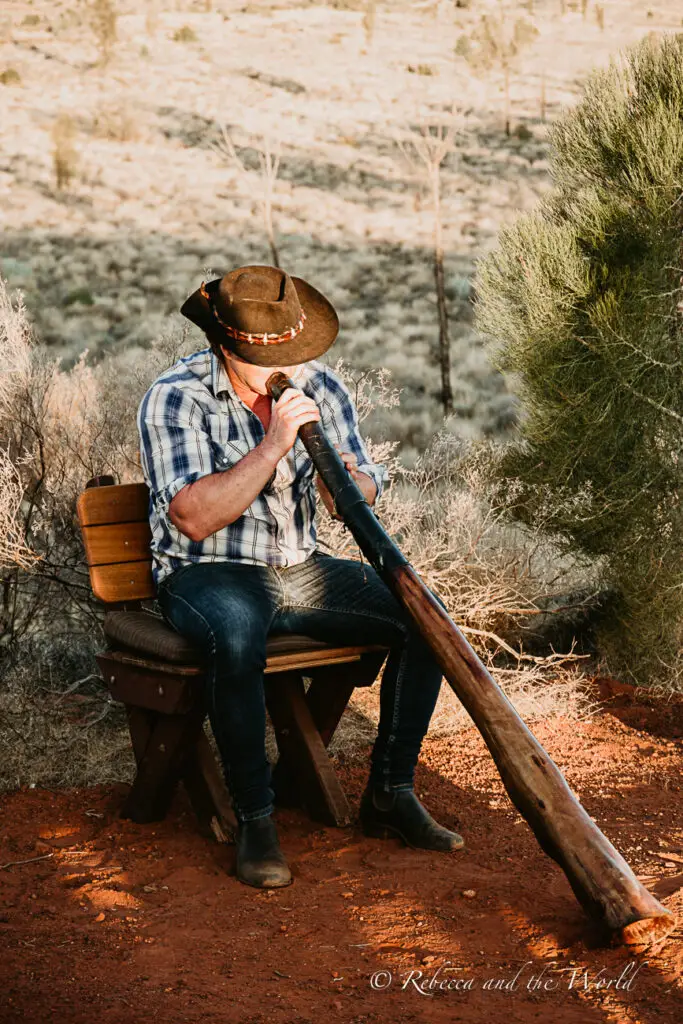
15. See Karlu Karlu at sunset
Karlu Karlu, also known as the Devil’s Marbles, is a sacred site for the Warumungu, Kaytetye, Alyawarre and Warlpiri people.
Located about 105 kilometres south of Tennant Creek in the Northern Territory, this unique natural wonder is an incredible sight to see at sunset.
The red and orange boulders glow in the warm light, creating a surreal landscape.
Take some time to wander through the boulders and appreciate their unique shapes and formations. You can also learn about their cultural significance from the few interpretive signs along the short walking trail.
There’s also a campground here, so you can even spend the night and enjoy a sunrise view of Karlu Karlu. You’ll need to book in advance, as spots fill up quickly during peak season – we unfortunately missed out on staying here, but did get a spot at the Devils Marbles Hotel a few minutes’ drive up the road.
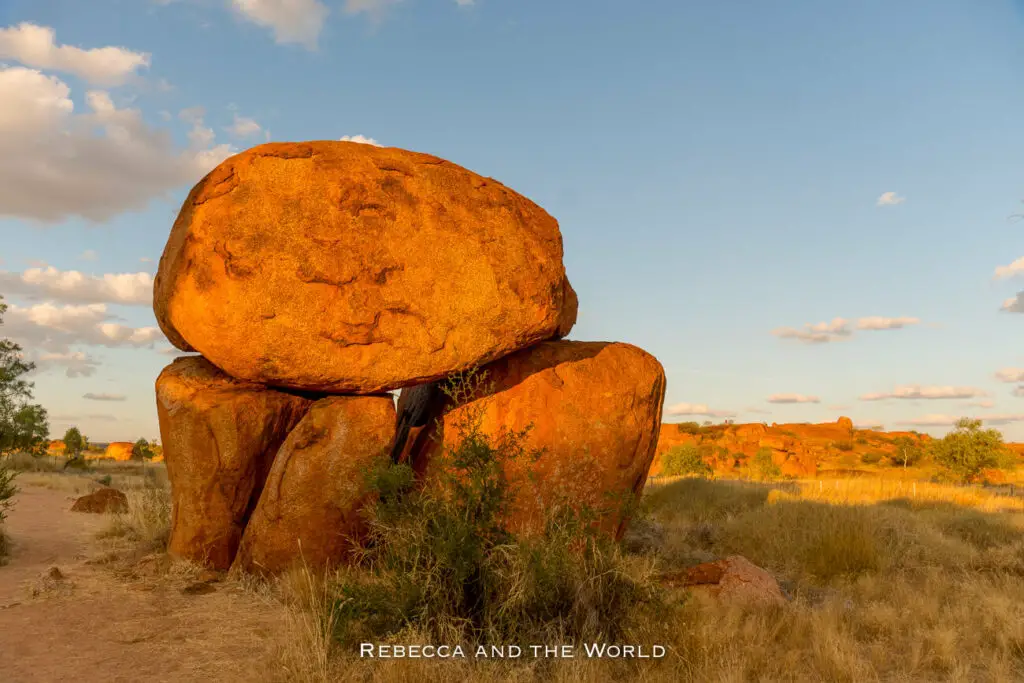
16. See ancient Aboriginal rock art
Australia is home to some of the oldest and most diverse Aboriginal rock art in the world. These ancient artworks can be found scattered throughout the country, providing a glimpse into the rich cultural history of Australia’s Indigenous peoples.
One of the best places to visit in the Northern Territory to see this incredible art is at Kakadu National Park.
Here, you’ll find rock art sites dating back thousands of years, depicting everything from animals and landscapes to spiritual beings and Dreamtime stories. Some of the most famous sites include Ubirr, Nourlangie and Nanguluwurr.
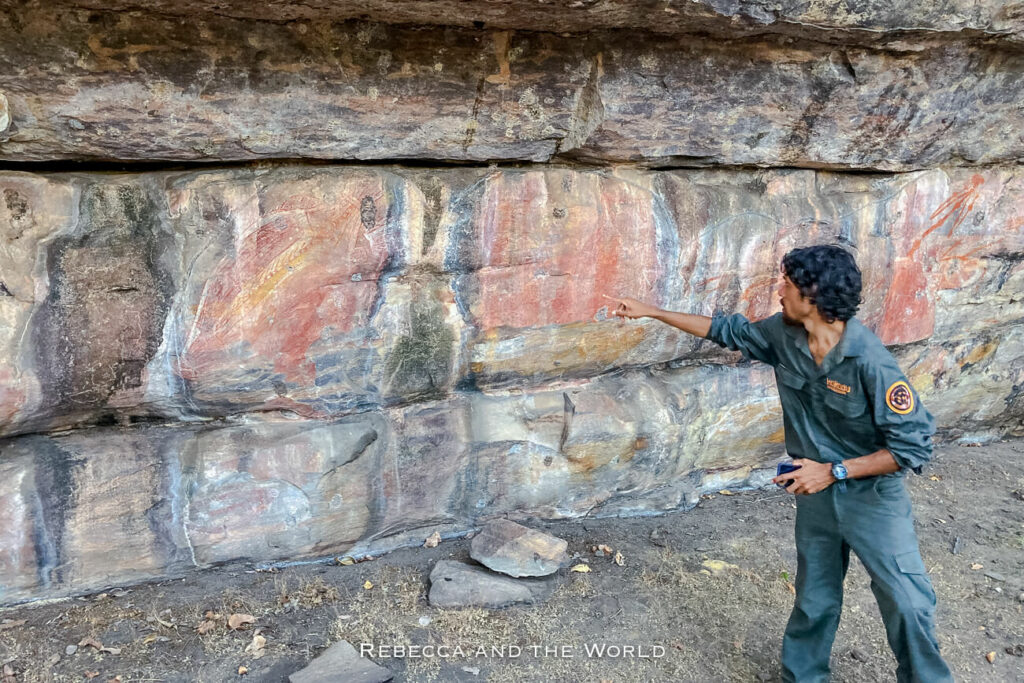
17. Leave a memento at the Daly Waters Pub
If you’re looking for a unique way to leave your mark in Australia, head to the famous Daly Waters Pub in the Northern Territory. This iconic pub has been a popular stop for travellers heading up or down the Stuart Highway since the early 1900s and is filled with thousands of mementos left by visitors from all over the world.
From signed t-shirts and hats to license plates and business cards, bras to thongs, the walls and ceilings of the pub are plastered in quirky memorabilia. Leave your own belongings and become a part of the pub’s rich history.
The pub is a classic Aussie pub, with plenty of cold beer, good (if overpriced) pub food and live music during the peak seasons. The owner is a bit of a quirky celebrity himself, and you’ll no doubt see him rounding up the animals each night through the main street in his motorised wheelchair.
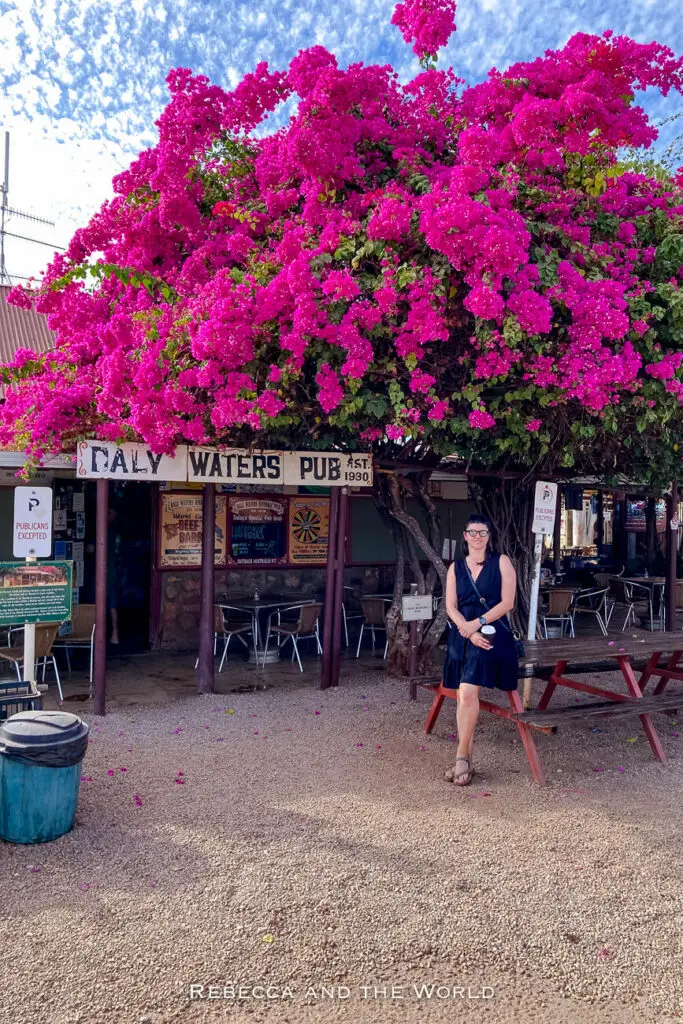
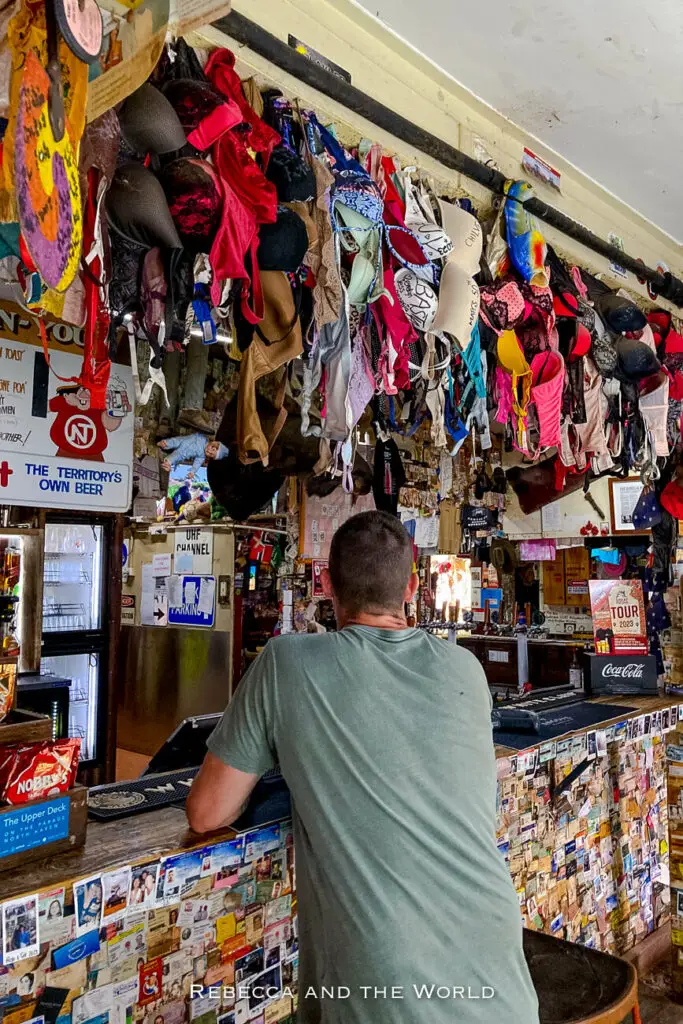
18. Visit the Pink Panther at the Larrimah Hotel
A remote pub on the Stuart Highway may not be the place you’d expect to see a giant pink panther statue – but it’s certainly helped to make the Larrimah Hotel famous.
Originally built in 1930 in a small town called Birdum situated on the railway line from Darwin, the pub was located to Larrimah in the late 1950s. It’s since become a popular spot for locals and tourists alike.
While the pub is no longer a pub, it is a good spot to break up your trip along the Stuart Highway and grab some snacks, including the famous pies and sausage rolls.
And if you’ve been reading, listening to or watching anything about the disappearance of Paddy and his dog, Kellie, don’t ask the staff about it…
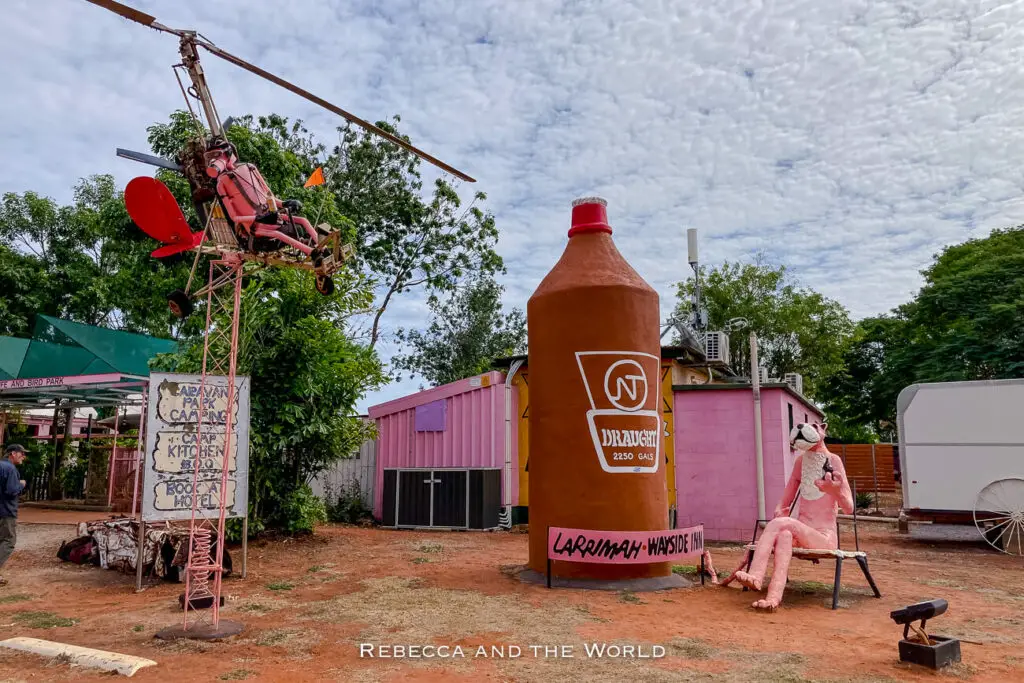
19. See crocs in the wild
The NT is home to some 100,000 crocodiles and you’ll no doubt see one as you’re road tripping through the Northern Territory.
There are both saltwater and freshwater crocs, and plenty of tours to see them.
I highly recommend the Yellow Water Billabong cruises at Kakadu National Park. On the 1.5 hour cruise, you’ll see dozens of crocs sunning themselves on the banks or lurking beneath the water’s surface. I started out counting them, but gave up because we saw so many.
Another entertaining way to see a crocodile in the wild is on a jumping croc cruise, one of the most popular tourist attractions in the Northern Territory.
These tours take you out on the Adelaide River, where the crocs have grown accustomed to fish scraps being thrown into the water. As a result, they jump right out of the water to snatch their food – it’s quite a spectacle! Just be sure to keep your arms and legs inside the boat at all times.
But you don’t even need a tour to see a croc in the NT – keep an eye out as you’re driving and you may spot one lurking in a billabong or river by the road. Just make sure to keep your distance and never approach or feed a wild crocodile – they may look slow and lazy, but they can move incredibly quickly!
And never put your toe in any water body in the NT without first checking it’s safe!
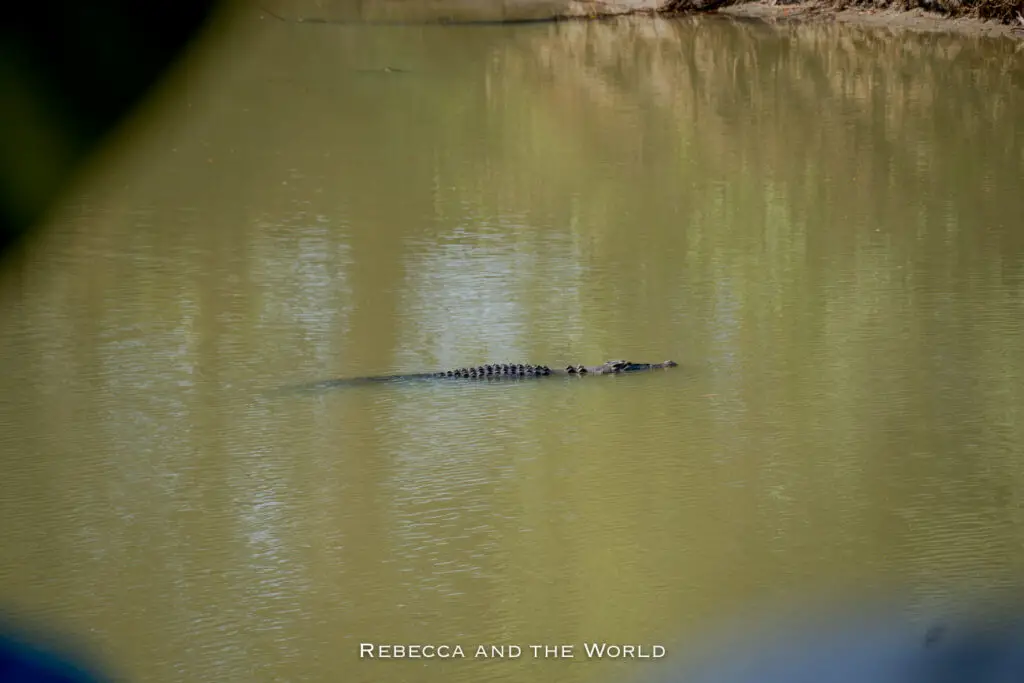
20. Swim with a croc
If seeing a croc in the wild wasn’t enough for you, then take a trip to Crocosaurus Cove in Darwin.
Here, you can get up close and personal with some of Australia’s most fearsome creatures. Take a dive into the Cage of Death and watch these massive reptiles swim around you, or opt for a more relaxed experience by watching them from the safety of a platform.
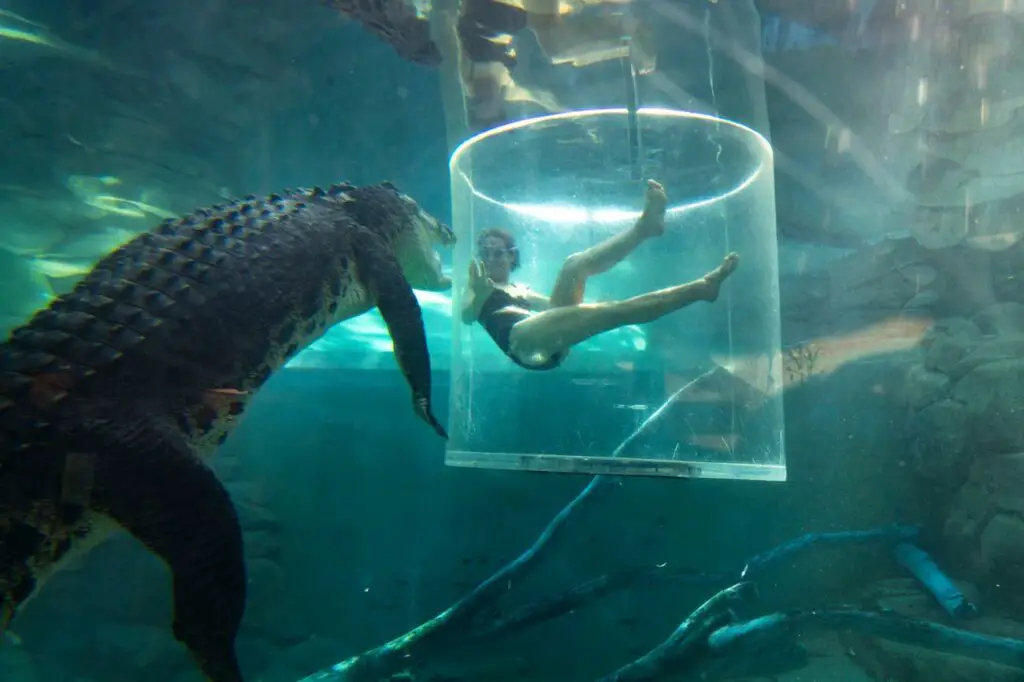
21. See Sweetheart
Crocodiles are part and parcel of life in the NT, and there’s no more famous croc than Sweetheart.
This 5.1-metre-long, 780kg crocodile was known for attacking fishing dinghies in the 1970s. As his attacks became more frequent, authorities made the decision to capture and move Sweetheart to a crocodile farm. Sadly, as he was being caught, he drowned.
This massive croc is now preserved and on display at the Museum & Art Gallery of the Northern Territory in Darwin. It’s incredible to see just how big he was!
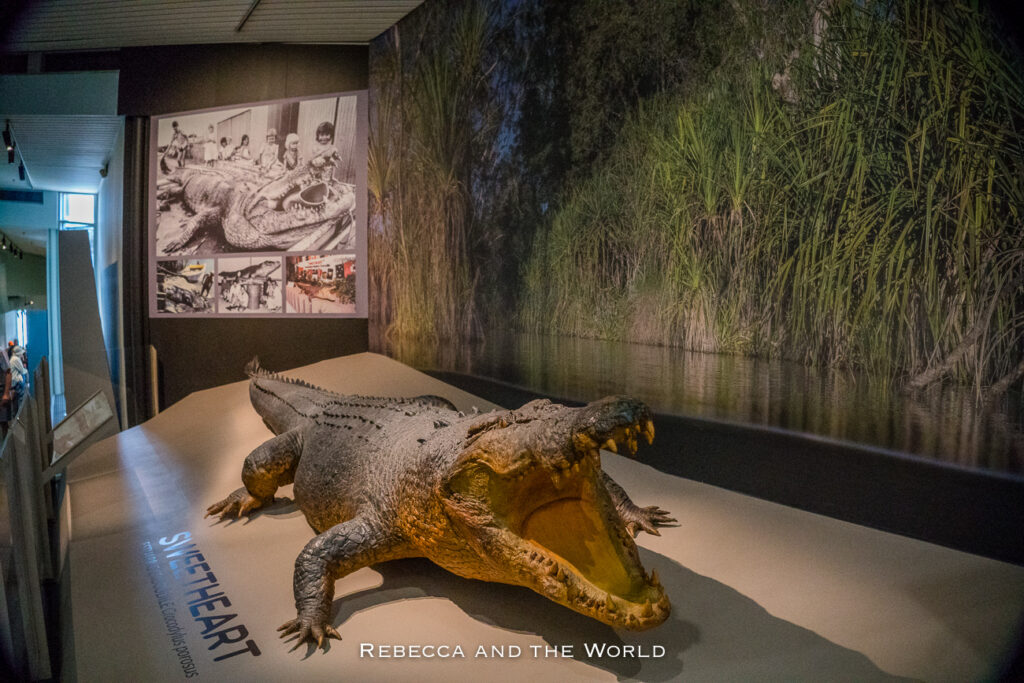
22. Go fishing for barra
Fishing in the Northern Territory is a popular pastime, and one of the most sought-after catches is the barramundi (“barra” for short). This fish can be found in rivers, creeks and billabongs throughout the NT.
But it’s not just about catching these prized fish – its about the whole experience of fishing in the NT. From the tranquility of being out on the water to cooking up your catch for a delicious dinner, there’s nothing quite like it.
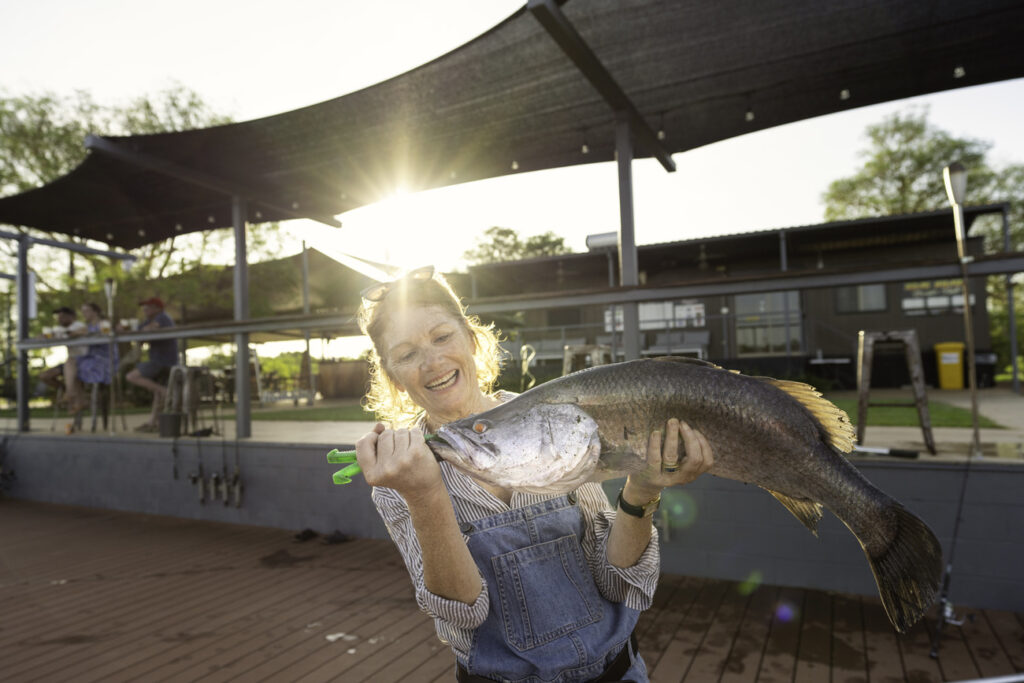
23. See a film outdoors
One of my favourite things to do in Darwin is catch a movie at the Deckchair Cinema.
Open during the dry season, this outdoor cinema is a fun way to see a movie with Darwin locals – as well as a few geckos scurrying across the screen as the movie plays.
There’s a bar and food available so you can make it a full night out.
It sells out pretty quickly, so book in advance.
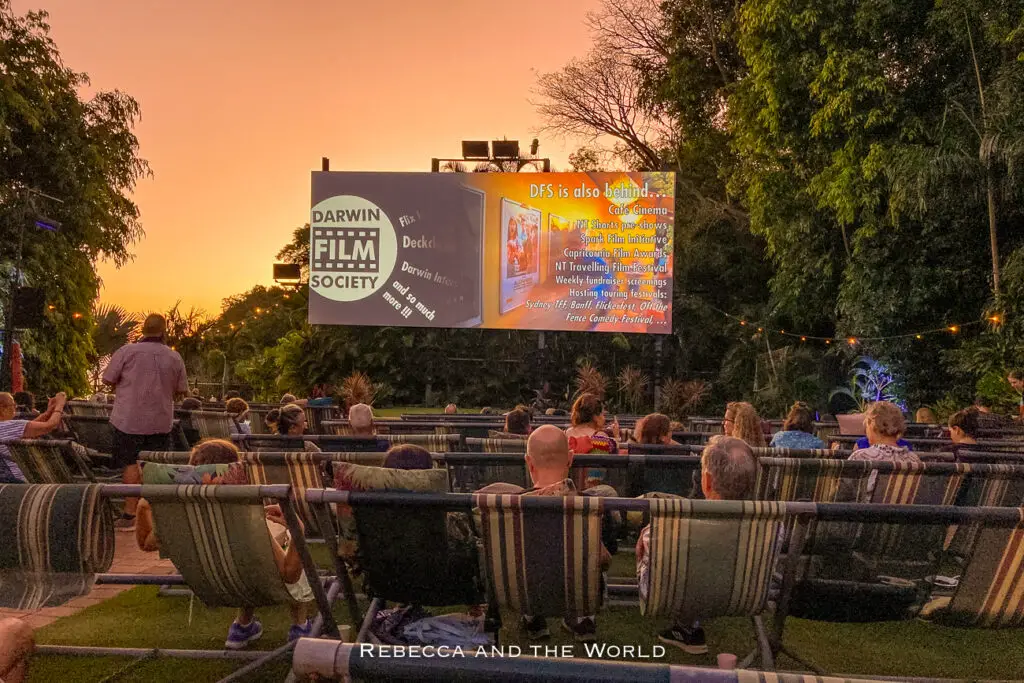
24. Visit Alice Springs
Alice Springs is known as the heart of Australia and it’s a must-visit destination for anyone travelling around the Northern Territory. This outback town offers a unique mix of culture, history and stunning landscapes and, while it gets a bad rap in the media, I really enjoy spending time here.
There are so many things to do in Alice Springs (or Mparntwe, as Alice is known in the Arrernte language). I love the Alice Springs Desert Park, where you can learn about native animals as well as Indigenous survival skills.
The Olive Pink Botanic Garden is another great spot for learning about the local flora and fauna.
The Araluen Cultural Centre has a great Aboriginal art gallery as well as the Museum of Central Australia and the Central Australian Aviation Museum, so you really can spend hours here.
And to see the town and surrounding region from above, consider a sunrise hot air balloon ride.
There are also some fantastic festivals to time your visit around, including the Alice Springs Beanie Festival, fabAlice (celebrating drag and cabaret) and Parrtjima, an annual light festival.
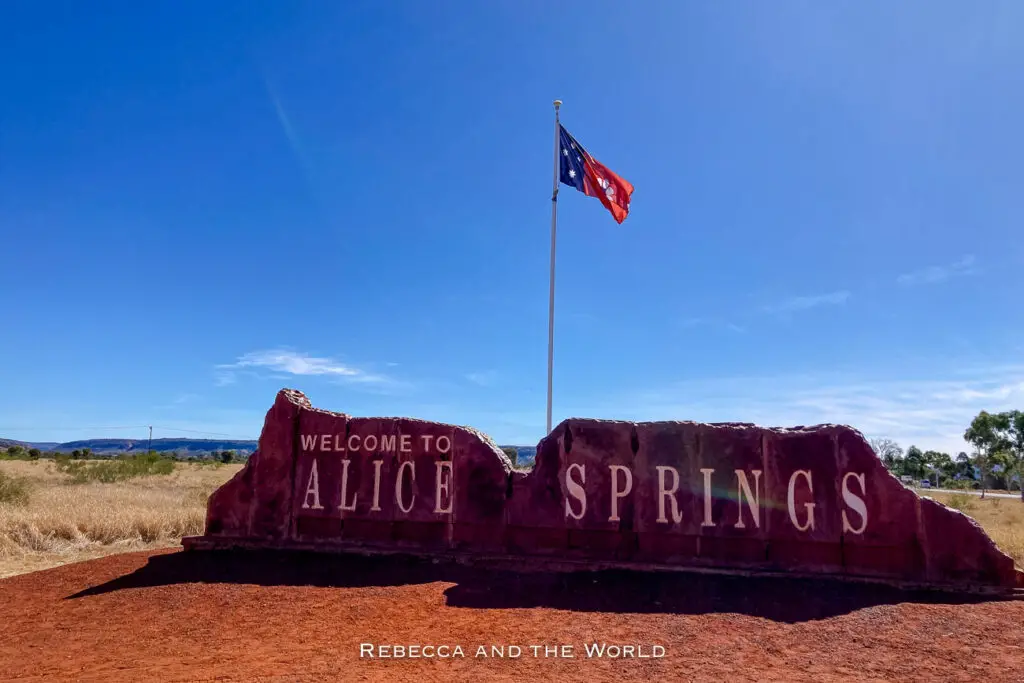
25. Explore the West MacDonnell Ranges
The West MacDonnell Ranges are a series of spectacular gorges and waterholes just outside of Alice Springs.
Here, you can hike through stunning landscapes, swim in refreshing waterholes and learn about the rich Indigenous culture and history of the area. Visit jaw-dropping spots like Ormiston Gorge, Simpsons Gap and Standley Chasm.
The best way to explore the West MacDonnell Ranges is by car, so rent one in Alice Springs. Camping is also possible at some of the gorges, so you can fully immerse yourself in the Outback.
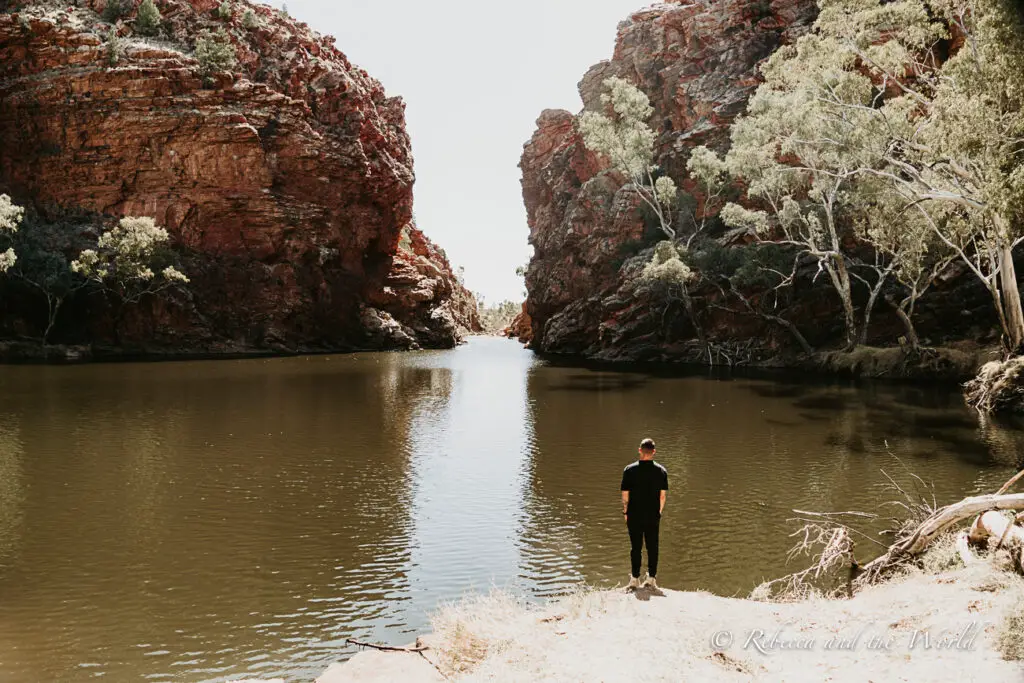
26. Stay the night at a roadhouse
Roadhouses are the lifeblood of the Australian Outback, and staying at one is an experience not to be missed. These roadside stops, found on major highways, have accommodation, fuel and supplies for travellers passing through.
Staying at a roadhouse means you can truly experience the isolated and rugged nature of the Australian outback. The night sky in these areas is absolutely breathtaking, with little to no light pollution. The only noise you’ll hear is the passing of road trains through the night (and they are pretty loud!).
It’s also a great way to meet people along the road and pick up travel tips.
Some of the best roadhouses we’ve stayed at in the NT are the Erldunda Roadhouse, which sits on the corner of the Stuart Highway and the Lasseter Highway (which leads to Uluru-Kata Tjuta National Park).
The Devils Marbles Hotel, while not technically a roadhouse, also has a great free camping site out the front – and you’re welcome to use the pub’s toilet and shower facilities.
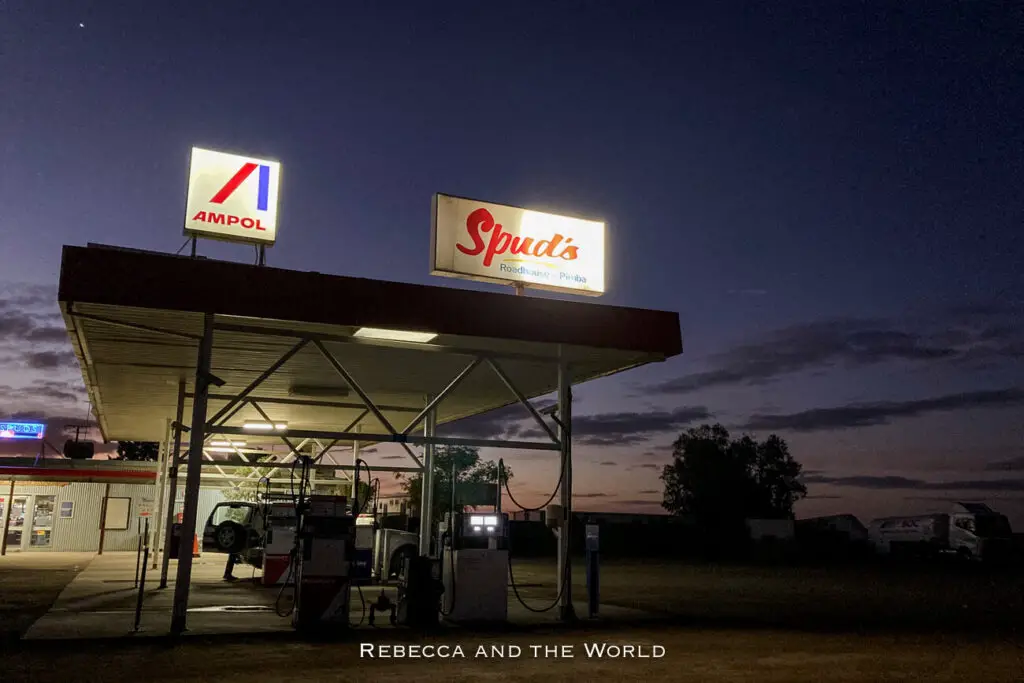
27. Learn about Indigenous culture
The Northern Territory is home to a rich and diverse Indigenous culture, with more than 100 different language groups and dialects.
Visit one of the many art galleries or attend a cultural event to gain insight into their way of life, beliefs and traditions. The Indigenous ranger-led talks at Kakadu are fascinating – and free. They cover all sorts of topics and locations around the national park during the dry season
In Katherine, Top Didj offers an interactive experience where you can learn about traditional hunting and gathering techniques, learn to throw a spear or try your hand at painting.
At Uluru, there are tonnes of free activities, including bush tucker talks and painting workshops. Maruku Arts is a popular (paid) class where you’ll undertake a hands-on dot painting workshop.
A 30-minute drive from Kings Canyon is Karrke, where you can participate in a one-hour Aboriginal Cultural Tour. It’s an immersive lesson in bush tucker, natural medicine and traditional art.
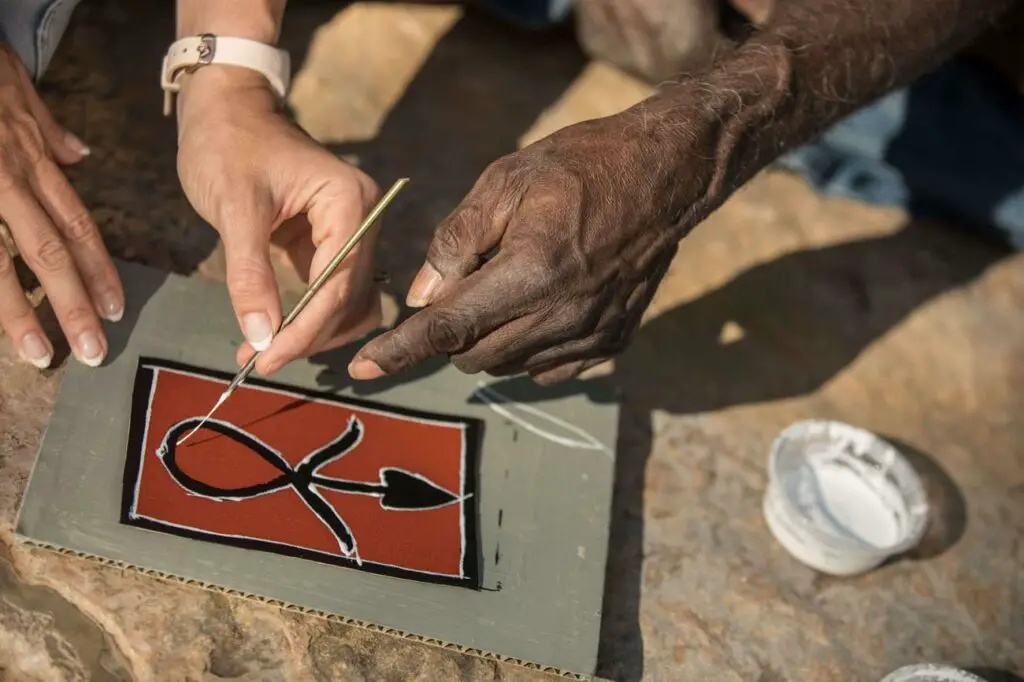
28. Experience a festival
The Northern Territory has some incredible festivals, and if you can time your visit with one of them, you won’t regret it.
The Darwin Festival is a 10-day celebration of art, culture and music held every August. It features local and international acts, dance performances, cabaret shows and delicious food stalls.
The quirky Darwin Lions Beer Can Regatta sees boats made from beer cans compete in races on Darwin’s harbour – so very Darwin!
The Alice Springs Beanie Festival celebrates the humble beanie with a quirky three-day festival in June. You’ll find everything from traditional Indigenous beanies to avant-garde creations.
In Alice, another festival worth planning your visit around is Parrtjima, an annual light festival that illuminates the desert and town with spectacular light installations. And fabALICE is a family-friendly celebration of drag and cabaret.
Barunga Festival is a three-day celebration of Indigenous culture, held in June. It’s a chance to engage with local communities and learn about their traditions through dance, music, art and sports.
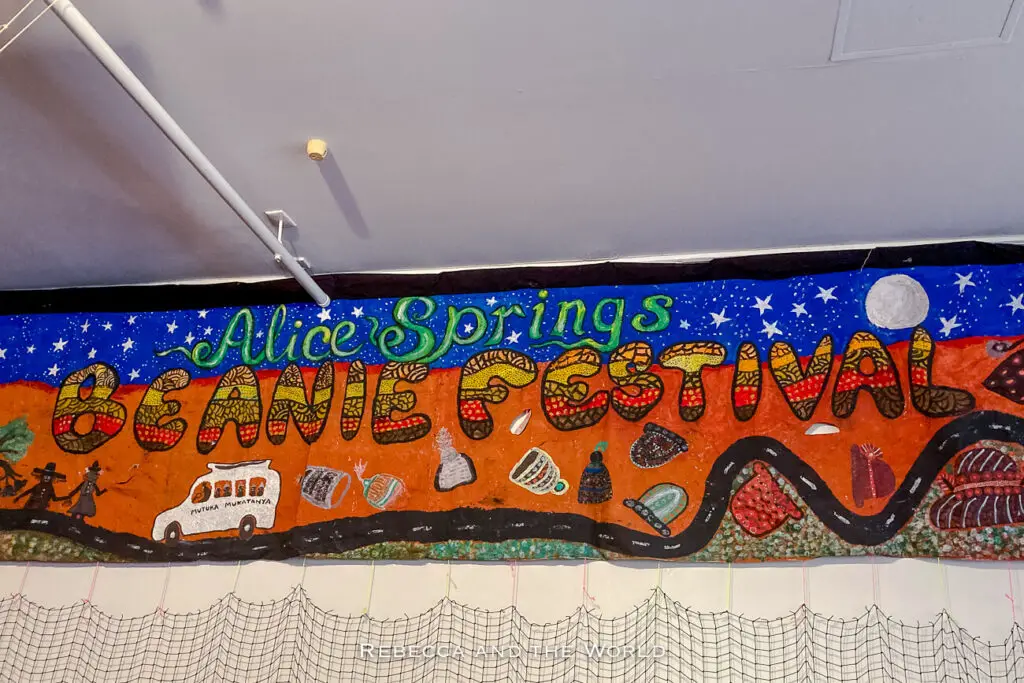
29. Visit the Tiwi Islands
Located 80km north of Darwin, the Tiwi Islands are a must-visit for those looking to experience Indigenous culture in its purest form. The Tiwi people have inhabited these islands for over 7,000 years and their traditions and way of life remain strong today.
To protect this culture, tourism is largely restricted, but you can visit by joining a tour to one of the two islands: Bathurst Island and Melville Island.
To visit the Tiwi Islands, you can take a ferry from Cullen Bay in Darwin or fly from Darwin Airport to either Bathurst or Melville Island.
The well-regarded Tiwi by Design tour includes the 2.5-hour ferry ride each way, from which you may be lucky enough to spot dolphins and sea turtles.
Once you arrive on Bathurst Island, you’ll be guided around the community, and welcomed with a traditional smoking ceremony and totem dances.
The highlight of the tour is taking part in a screen-printing workshop, where you’ll choose Tiwi designs to print onto your own t-shirt or tea towel.
You can also book a stay at Tiwi Island Retreat. This beachfront property looks incredible!
BOOK THE TIWI BY DESIGN TOUR HERE
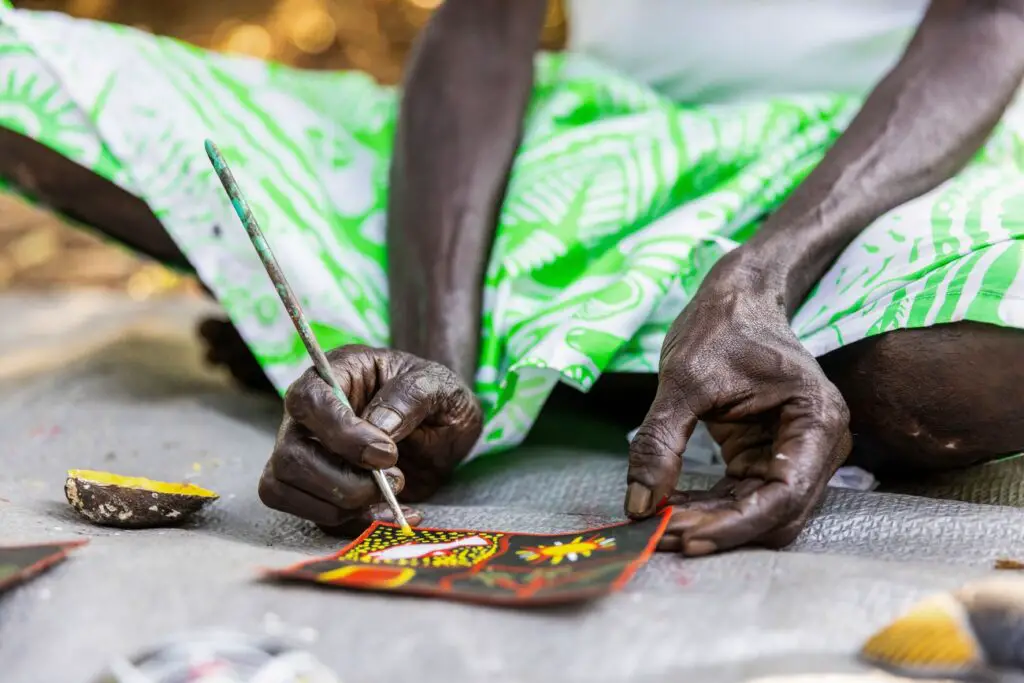
30. Learn about World War II history in Darwin
As one of the main bases for the Allied forces in the Pacific, the Northern Territory played a significant role in World War II.
The Darwin Military Museum is a must-visit for history buffs. Here, you can learn about the bombing of Darwin in 1942 through interactive exhibits and displays of artefacts from the war. There are dozens of military vehicles, as well as displays about other wars around the world such as the Vietnam War.
I really enjoyed the Darwin Military Museum. And even though a lot of the artefacts are outside, it’s nicely shaded from the daytime heat.
You can also walk around nearby East Point Military Precinct to see remnants of gun emplacements and bunkers used during the war.
The oil storage tunnels are another fascinating spot. Built in 1942, they were once used to store oil and ammunition, but are now open for guided tours.
If you really want to dig into Darwin’s past, there’s a tour around the city in an old WWII army truck. We saw this truck at the Darwin Military Museum and my friend’s dad has taken the tour, which visits ammunitions storage bunkers, the Qantas hangar and the East Point Gun Battery and Military precinct. You can find out more about The Darwin History and Wartime Experience online here.
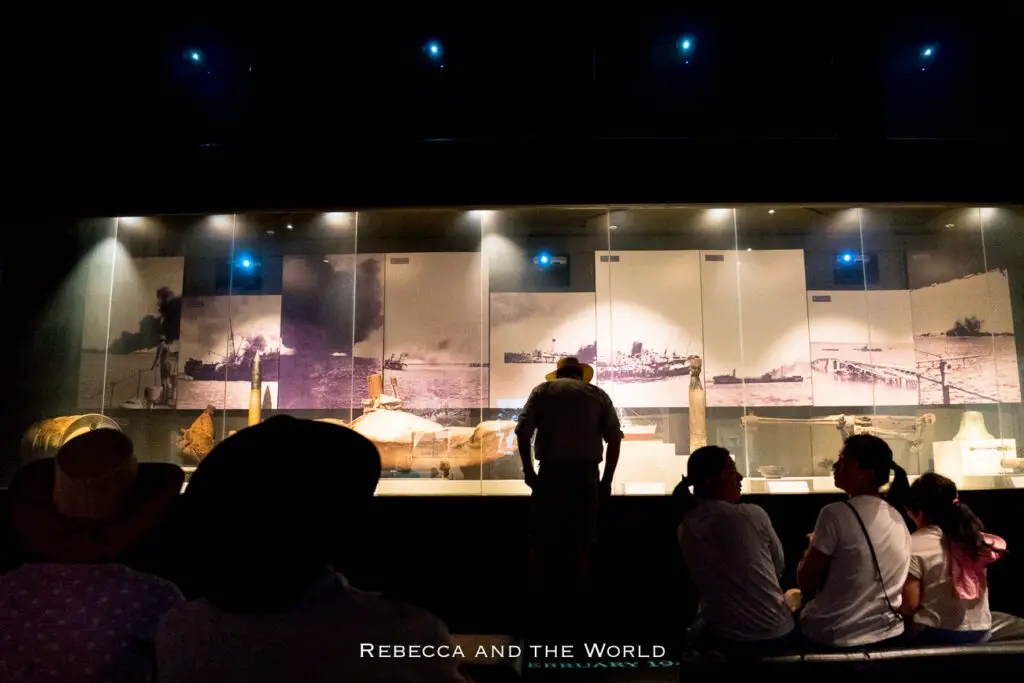
31. See native wildlife
In the Northern Territory, you’ll have the opportunity to see unique and fascinating wildlife that can’t be found anywhere else in the world. I’ve seen (and heard) birds that aren’t found in my home state of Victoria.
The best place to start is at the Alice Springs Desert Park, where you’ll see everything from kangaroos to emus, dingoes and reptiles in their natural habitats.
This is a fantastic place to visit with kids – but adults will love it as well. My favourite part is the Nocturnal House, with habitats that mimic the evening and night so that you can see rare and endangered animals that only come out when it’s dark.
For an up-close experience with kangaroos, head to the Kangaroo Sanctuary in Alice Springs. This sanctuary is home to rescued orphaned kangaroos. There are guided sunset tours where you can feed and interact with joeys and older kangaroos.
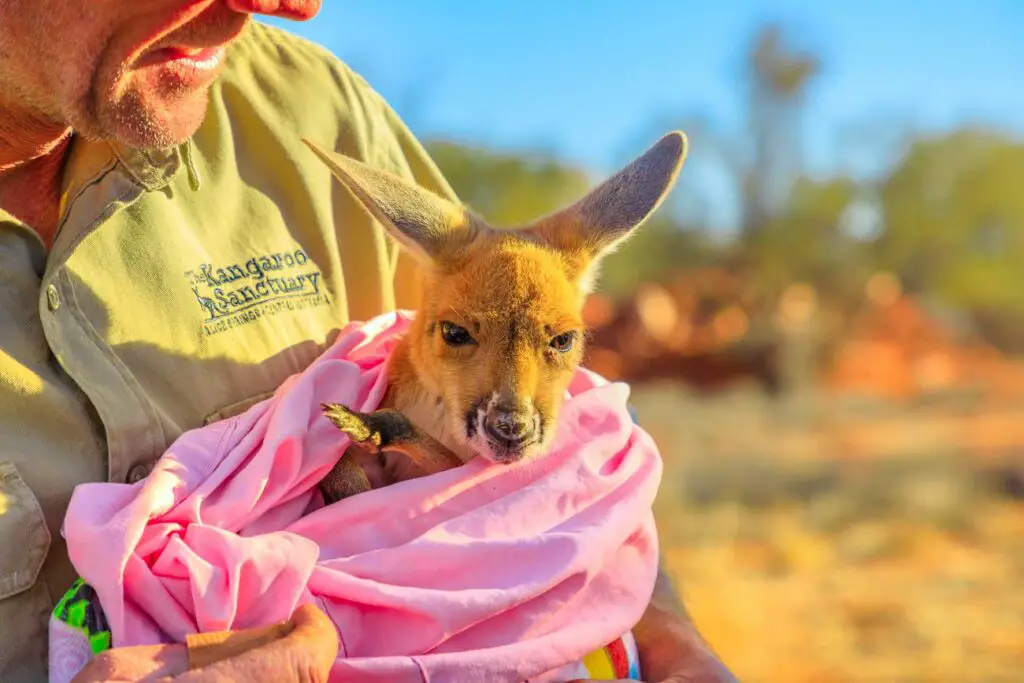
32. Go stargazing at Earth Sanctuary
The remoteness of the Northern Territory means lots of dark, clear skies, making it the perfect place for stargazing.
And there’s no better place to do it than at Earth Sanctuary, located just outside of Alice Springs.
At Earth Sanctuary, you can take an astronomy tour with a guide who will point out constellations and planets and share stories of the night sky. You’ll also get to use telescopes and learn about Indigenous astronomy and Creation stories.
As the Earth moves around the sun, the sky changes, so each night of the tour is completely different.
Or you can even stay the night in a “star bed” and gaze up at the stars all night long.
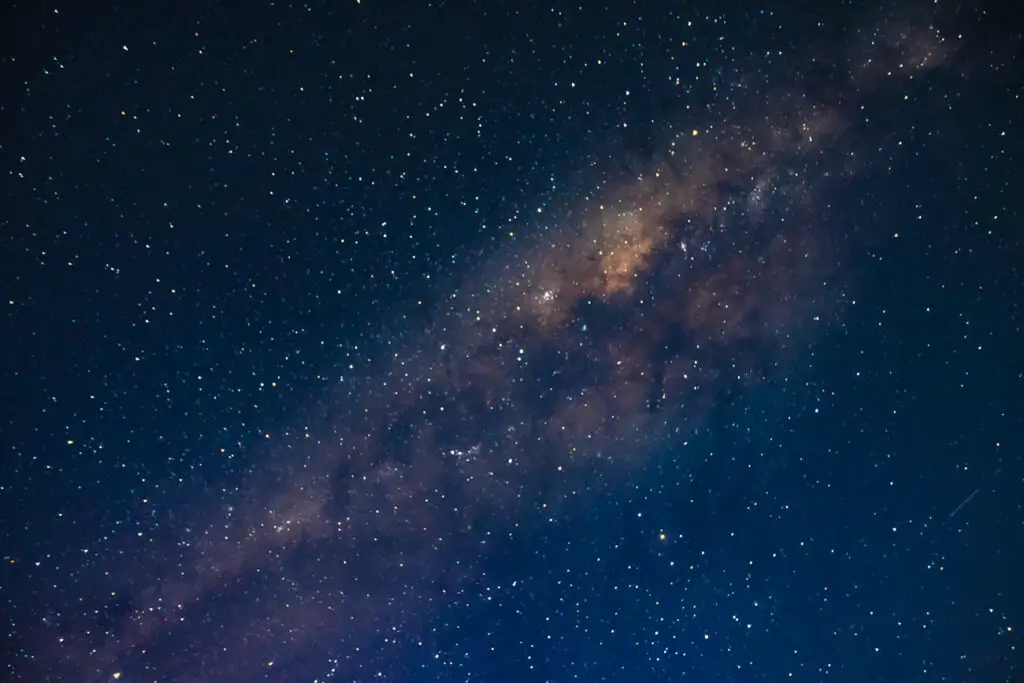
33. Go on a pub crawl – in a helicopter
There’s nothing more NT than taking a pub crawl around the Top End – in a helicopter!!
This one-of-a-kind tour will take you to some of the most iconic pubs in the region. Beats an Uber home from the pub!
There are two companies in Darwin that run the tours. On either tour, you’ll stop at various bush pubs. These pubs are known for their laid-back atmosphere and interesting locals, making for a fun and memorable pub crawl experience.
I haven’t yet done this but it’s on my Australia bucket list!
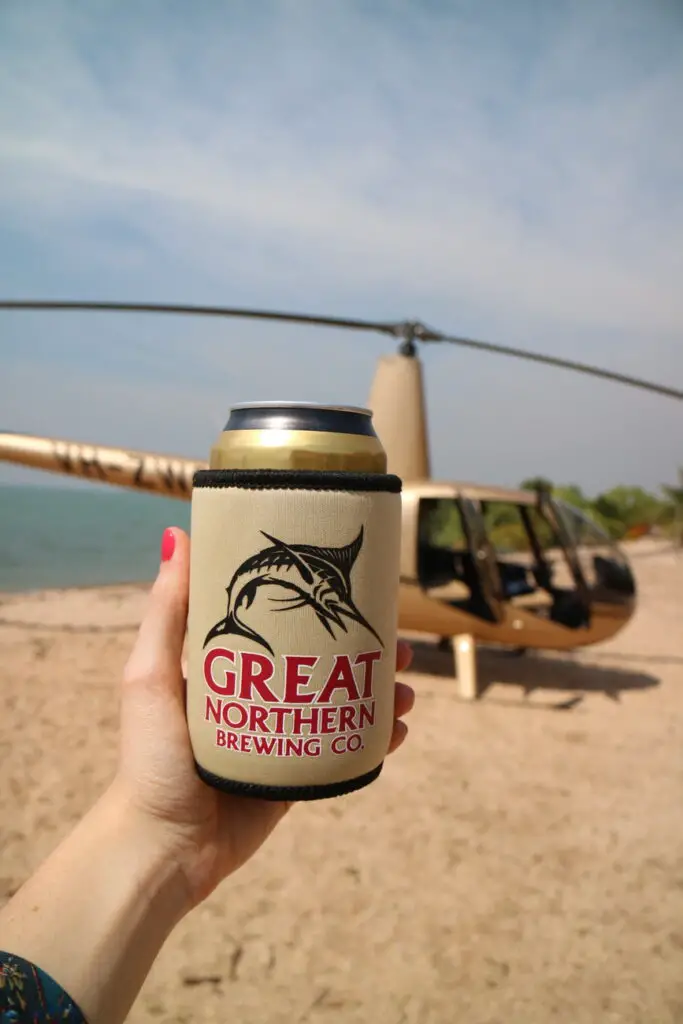
34. Try camel and croc
The Northern Territory has some great food to try.
Barramundi is a must, if you enjoy fish. It’s on practically every restaurant menu.
Darwin’s proximity to Southeast Asia means its cuisines have been influenced by countries like Indonesia, Malaysia, Vietnam and Thailand. I’ve eaten chicken slathered in delicious satay sauce and slurped down creamy lakas. Laksas are so popular up here that there are laksa cult followings and even a month-long laksa festival!
But while you’re in the NT, why not try something a little more unique?
Camel and crocodile are two popular meats found on menus throughout the NT. Camel is a lean, healthy alternative to beef and has a similar taste. I’ve tried this in a burger at the Kings Creek Station.
Crocodile meat is also low in fat and high in protein. You’ll find it on menus throughout the Top End in spring rolls, deep fried or served as fish and chips.
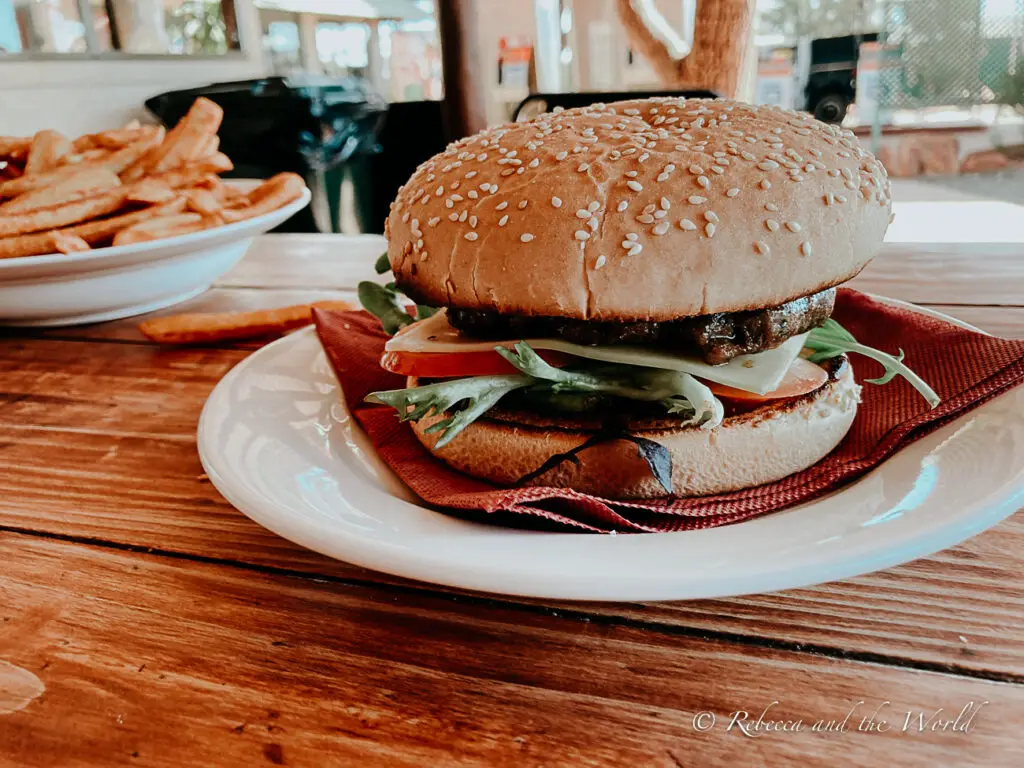
35. Camp under the stars
With plenty of open space and minimal light pollution, the Northern Territory is the perfect place to camp out under the stars.
Spend a night in the outback and witness the expansive sky lit up with countless stars.
There are camping sites all across the state, some free, some paid. You can camp in national parks – but you often have to book well in advance to get a spot during the peak season (especially during school holidays).
Pack your tent and sleeping bag or upgrade your camping experience by renting a campervan or motorhome.
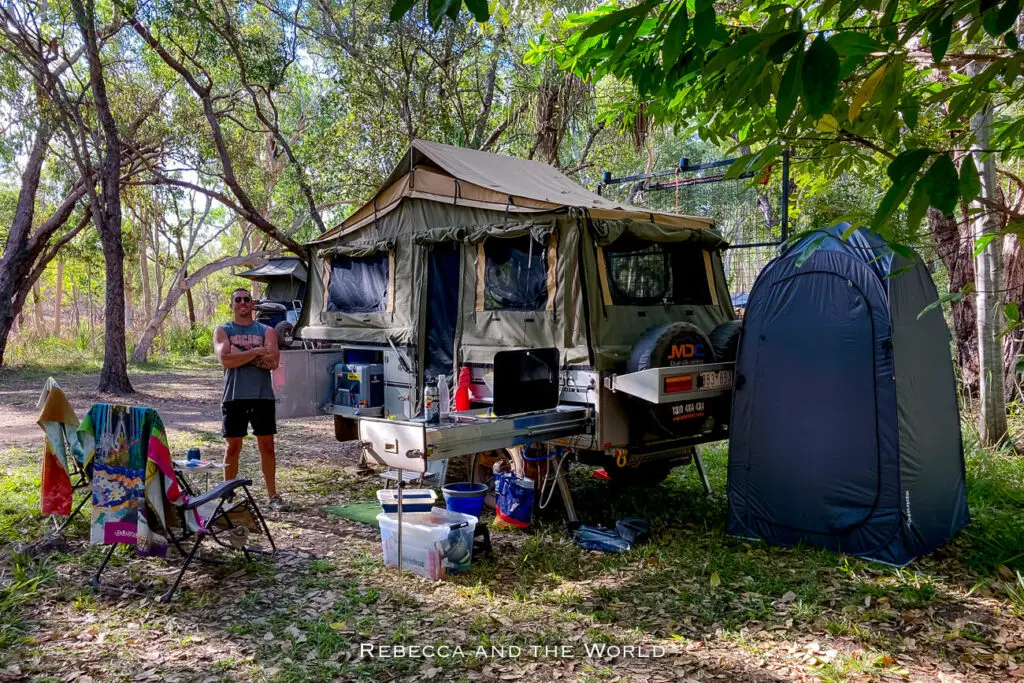
Best time to visit the Northern Territory
The Northern Territory has a tropical climate, meaning it has two main seasons: the dry season and the wet season. For most people, the best time to visit the NT will be the dry season, from May to October.
The dry season is typically the peak tourist season in the Northern Territory as it brings cooler temperatures and little rainfall.
The wet season, from November to April, brings heavy rainfall and high humidity, which can make it difficult for outdoor activities. However, this is also the best time to witness the stunning waterfalls in full flow and the lush greenery of the region.
How to get to the Northern Territory
The most common way to get to the Northern Territory is by flying into one of its major cities, such as Darwin or Alice Springs. These two cities have airports with the most connections around Australia (although the NT is still underserved by flights).
SEARCH FOR FLIGHTS TO THE NORTHERN TERRITORY HERE
If you prefer a more adventurous route, you can also travel by road or rail. An Adelaide to Darwin road trip is epic – and one of my unmissable things to do in the Northern Territory! – covering 3,000 kilometres.
The famous Ghan train runs from Adelaide to Darwin and provides a scenic journey through the Australian Outback.
How to get around the NT
With such vast and remote landscapes, you’ll need a car to get around the NT.
Rent a car in Darwin, Alice Springs or Katherine. Most roads are sealed, so a 2WD will be fine for your trip. But if you want to get off-the-beaten-path, then a 4WD is best.
I’m also a huge fan of hiring a campervan in the NT. It’s a fun way to get around – and means you can combine your transport and accommodation in one. There are plenty of free and paid camping and caravan sites all around the state, as well as rest stops by the side of the road.
There are also several multi-day tours that cover the highlights of the NT.
What to pack for an NT trip
The Northern Territory is known for its extreme weather conditions, ranging from hot and humid summers to cooler desert nights. Pack clothes that can adapt to different temperatures.
Some must-pack items include:
- Lightweight, breathable clothing
- Sun protection – sunscreen, sunglasses, a hat and a lightweight long-sleeved shirt
- Good hiking or walking shoes (these are my go-tos)
- Insect repellent
- Mosquito head net
- Swimwear – to take advantage of all the swimming holes and waterfalls
- Camera
- Reusable water bottle
- Adapters and chargers – if you’re a visitor to Australia, the NT uses the three-prong, Type I standard plug
- A small first aid kit
- Cash – it’s always a good idea to have some cash on hand, especially when travelling to more remote areas
Final thoughts: Roadtripping the NT
The Northern Territory is one of the most diverse and fascinating parts of Australia. If you’re visiting Australia, you might be tempted to sticcagek to the East Coast and visit Sydney and Melbourne. But if you make the longer journey up north, you’ll go home with memories and stories to tell your friends and family.
It’s one of my favourite parts of Australia and was an absolute highlight of our recent half-lap of the country.
Did you find this article helpful? Consider buying me a coffee as a way to say thanks!
Have you been to the NT? What are your favourite things to do in the Northern Territory?
Related posts
Before you go… you might like these Australia travel articles:
- An epic Adelaide to Darwin road trip itinerary
- 10-day Northern Territory road trip
- 19 spectacular things to do at Uluru
- How to spend a few days in Alice Springs
- The best things to do in Katherine, NT
- The best things to do in Nitmiluk National Park
- The ultimate guide to Litchfield National Park
- How to spend a few days in Kakadu National Park
- The best things to do in Darwin
- The ultimate Australia bucket list
AUSTRALIA TRIP ESSENTIALS
- Book your flight to Australia online with Skyscanner. I like this site because it shows me which dates are cheaper.
- Find a great hotel in Australia. Check prices on Booking.com and Expedia online.
- Check out the huge range of day tours throughout Australia on GetYourGuide or Viator. There’s something for everyone.
- A copy of the Lonely Planet guide to Australia will be handy.
- One thing I always purchase is travel insurance! Travel Insurance Master allows you to compare across multiple policy providers, while SafetyWing is great for long-term travellers and digital nomads.
- Pack sunscreen (look for SPF50 or higher), a hat and sunglasses because the sun is hot!
PIN IT FOR LATER: THE BEST THINGS TO DO IN THE NORTHERN TERRITORY
Save this Northern Territory travel guide to Pinterest so you can plan your travels later!
